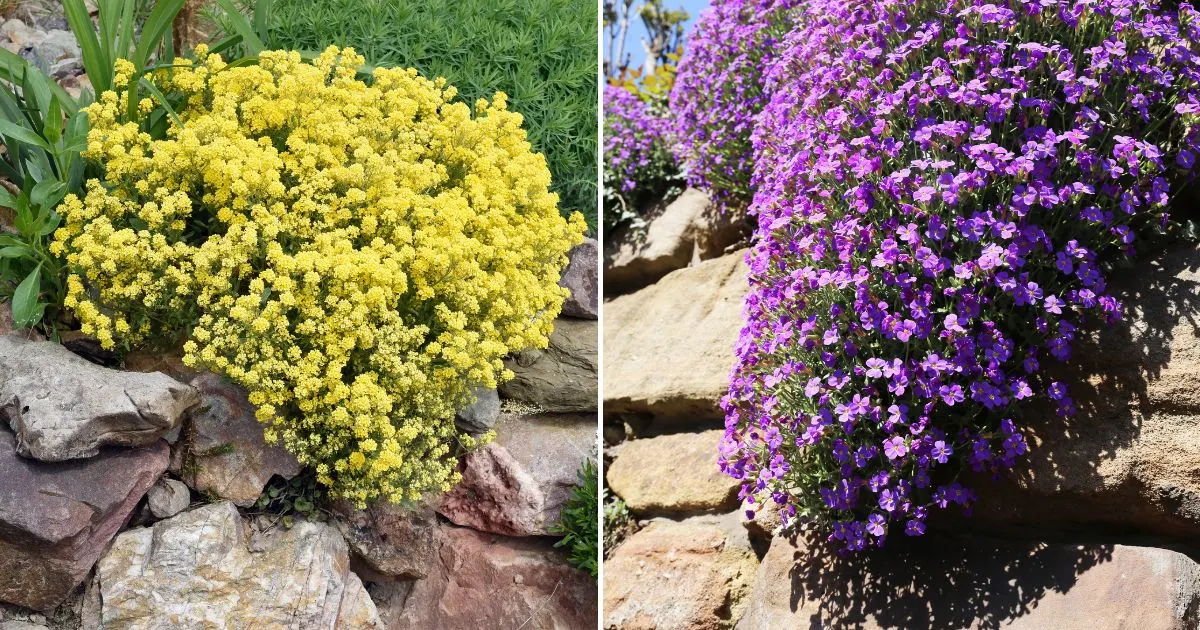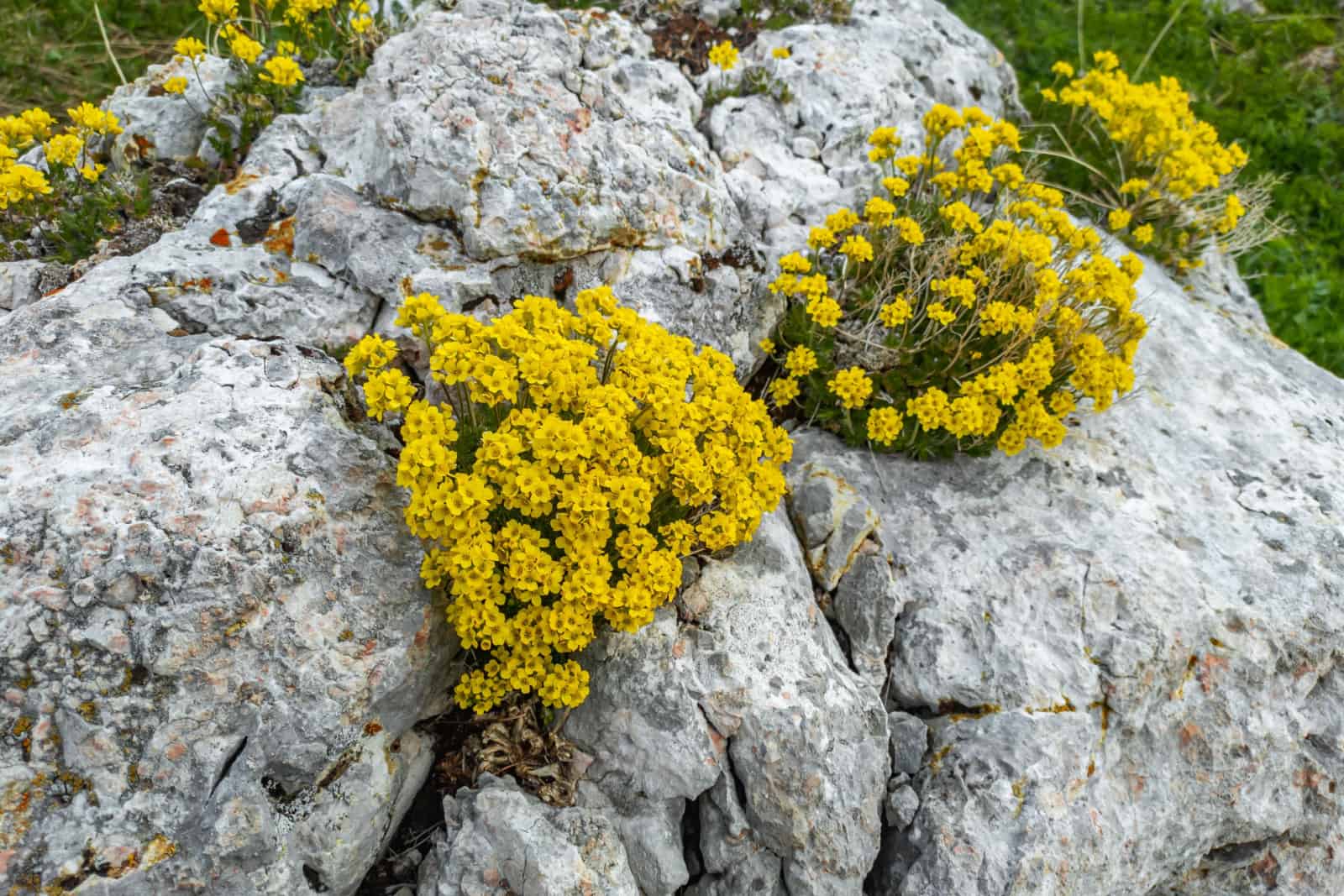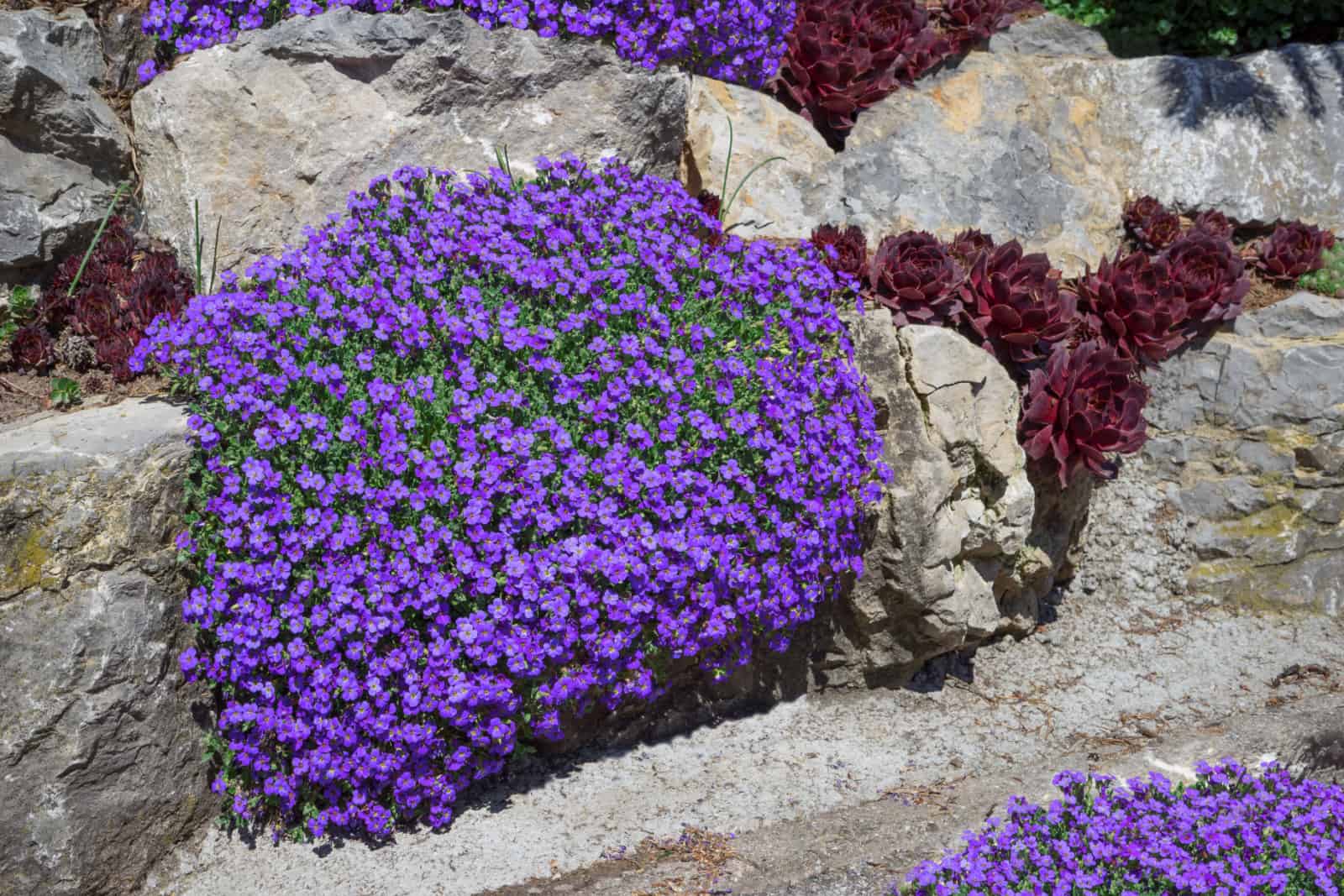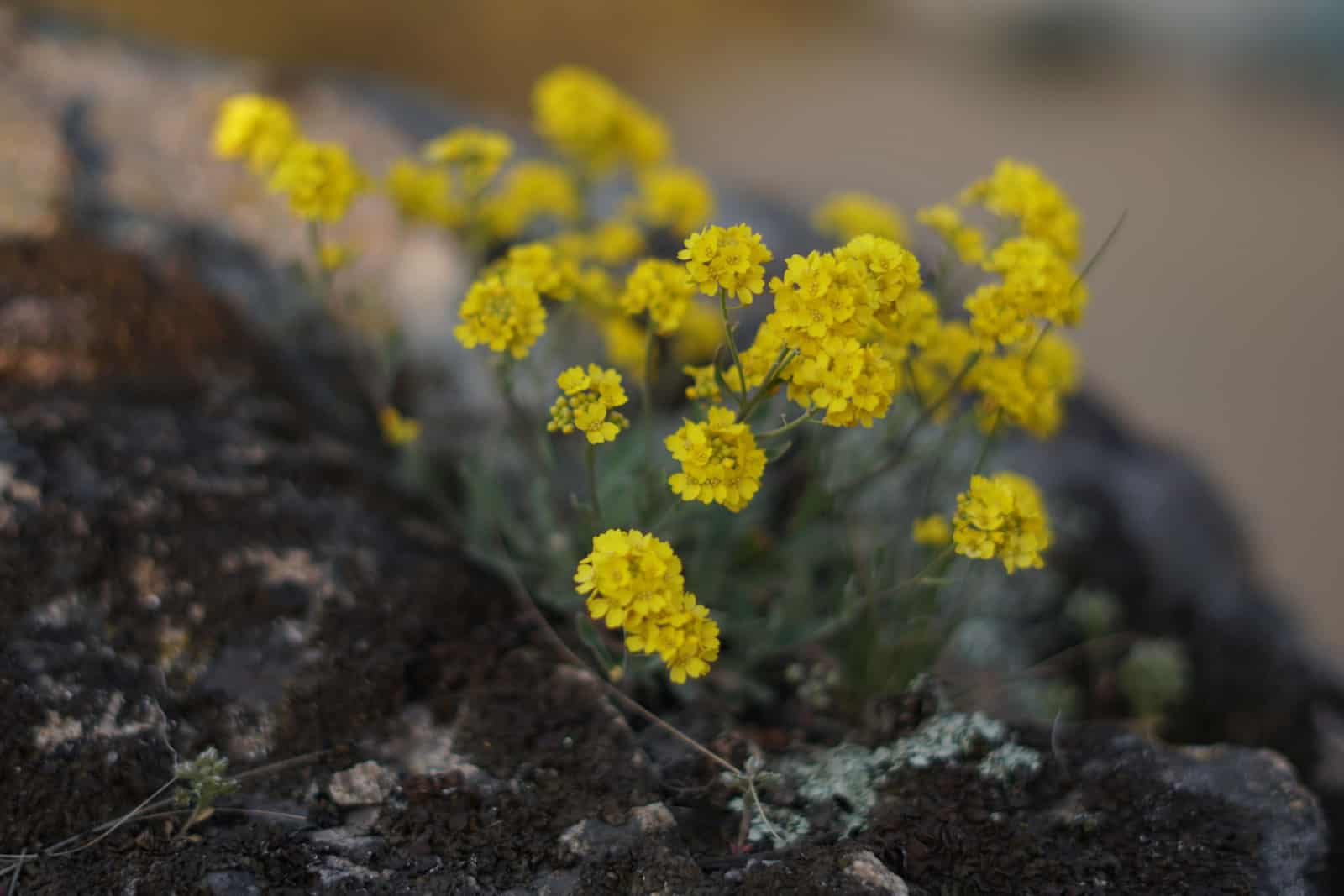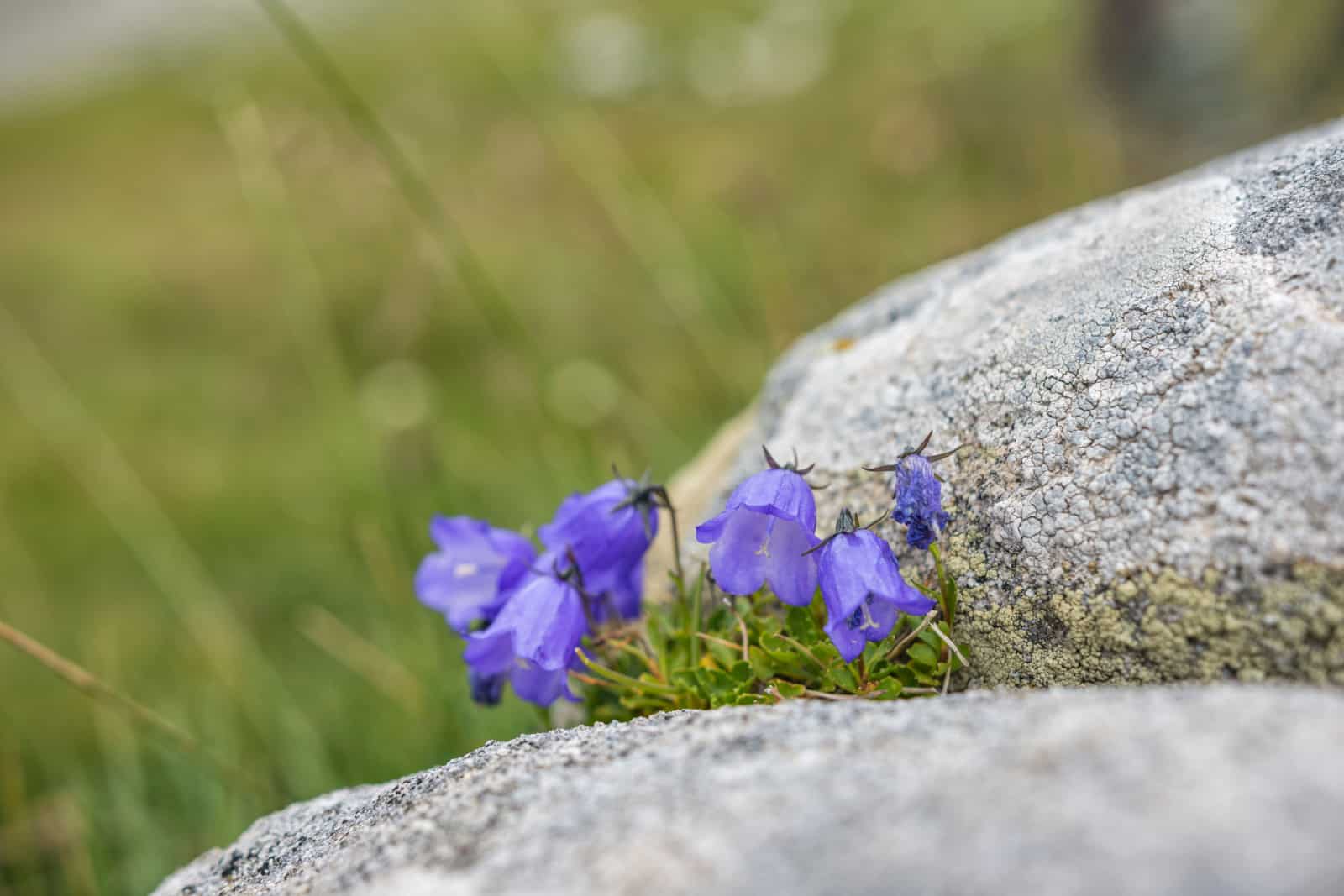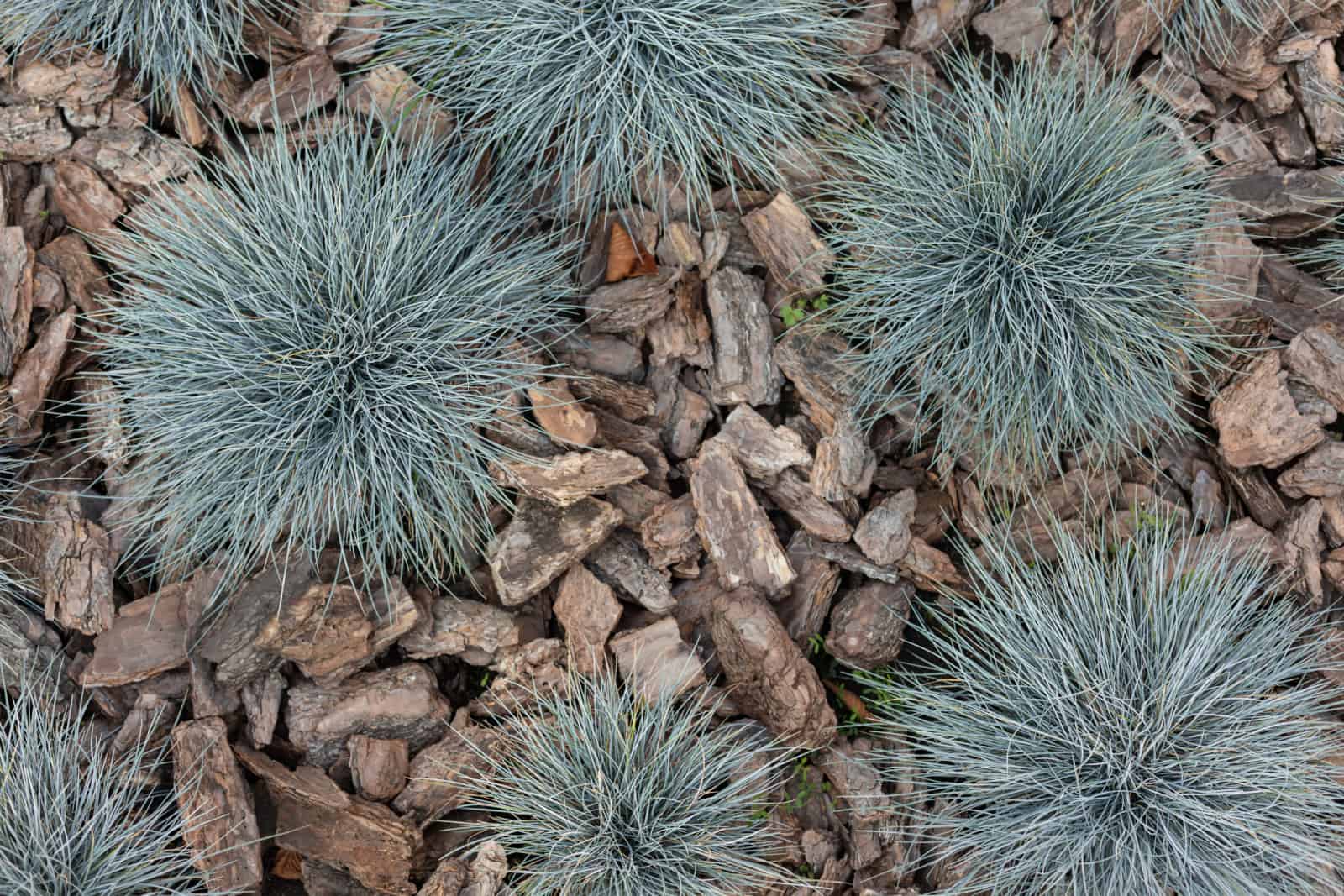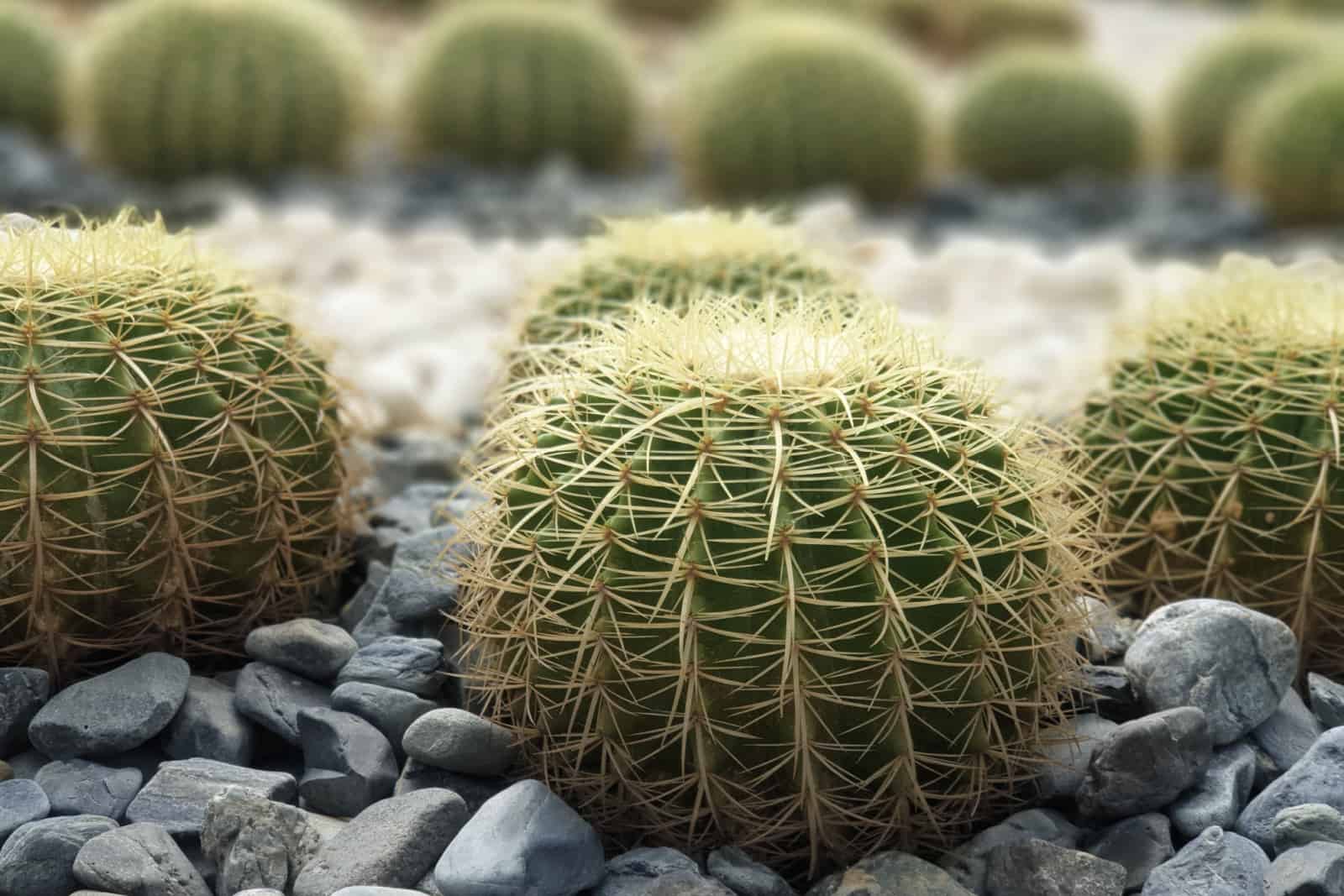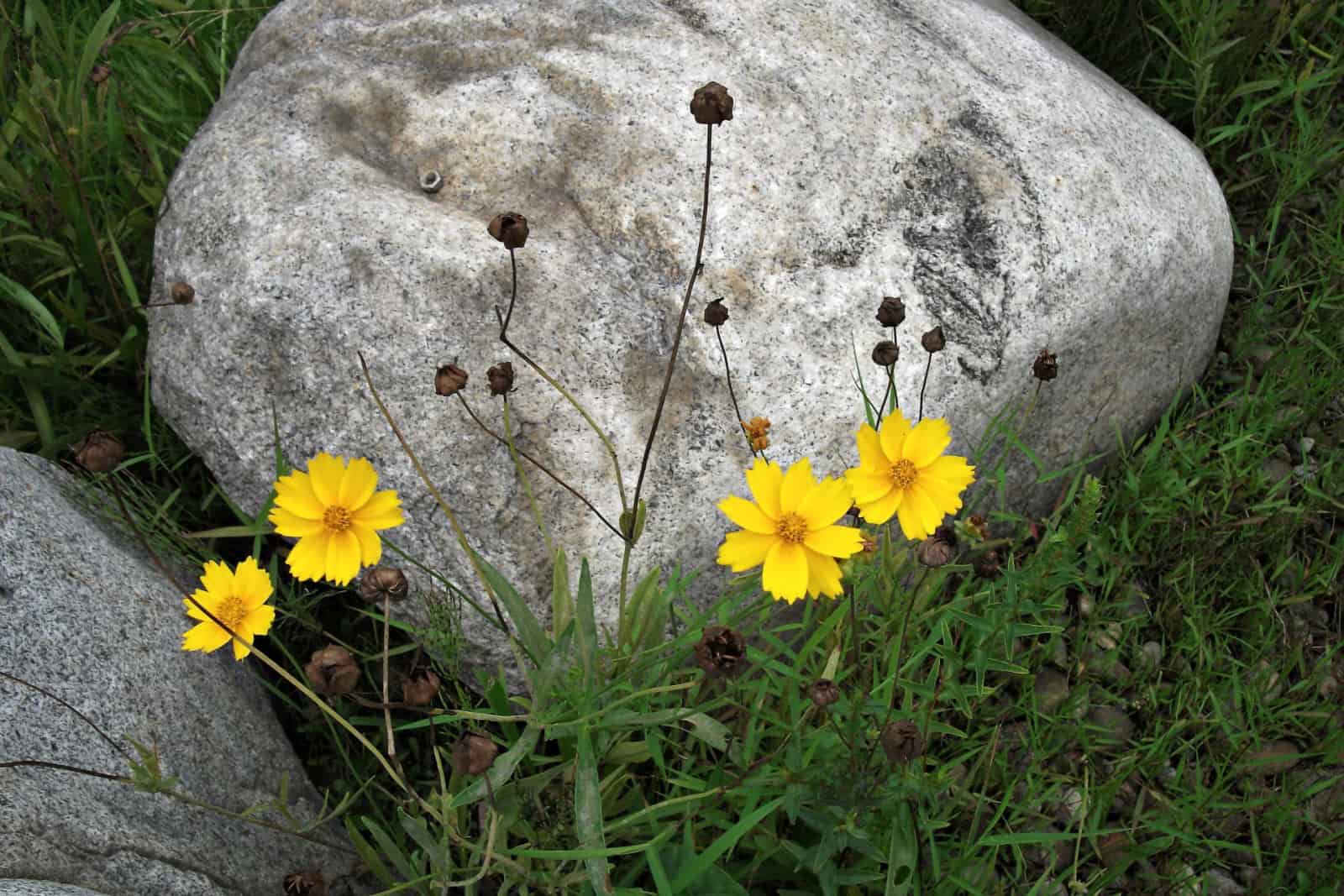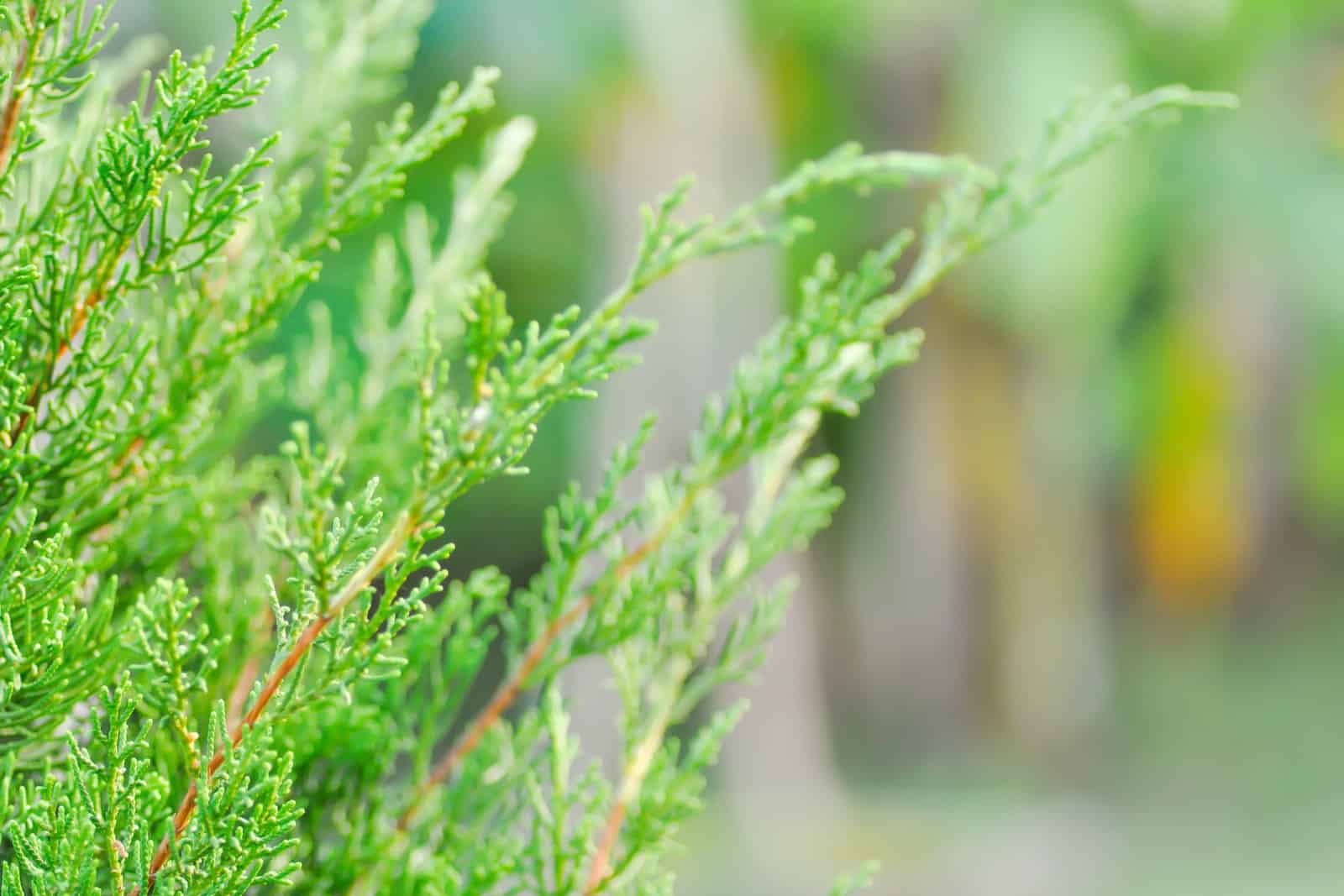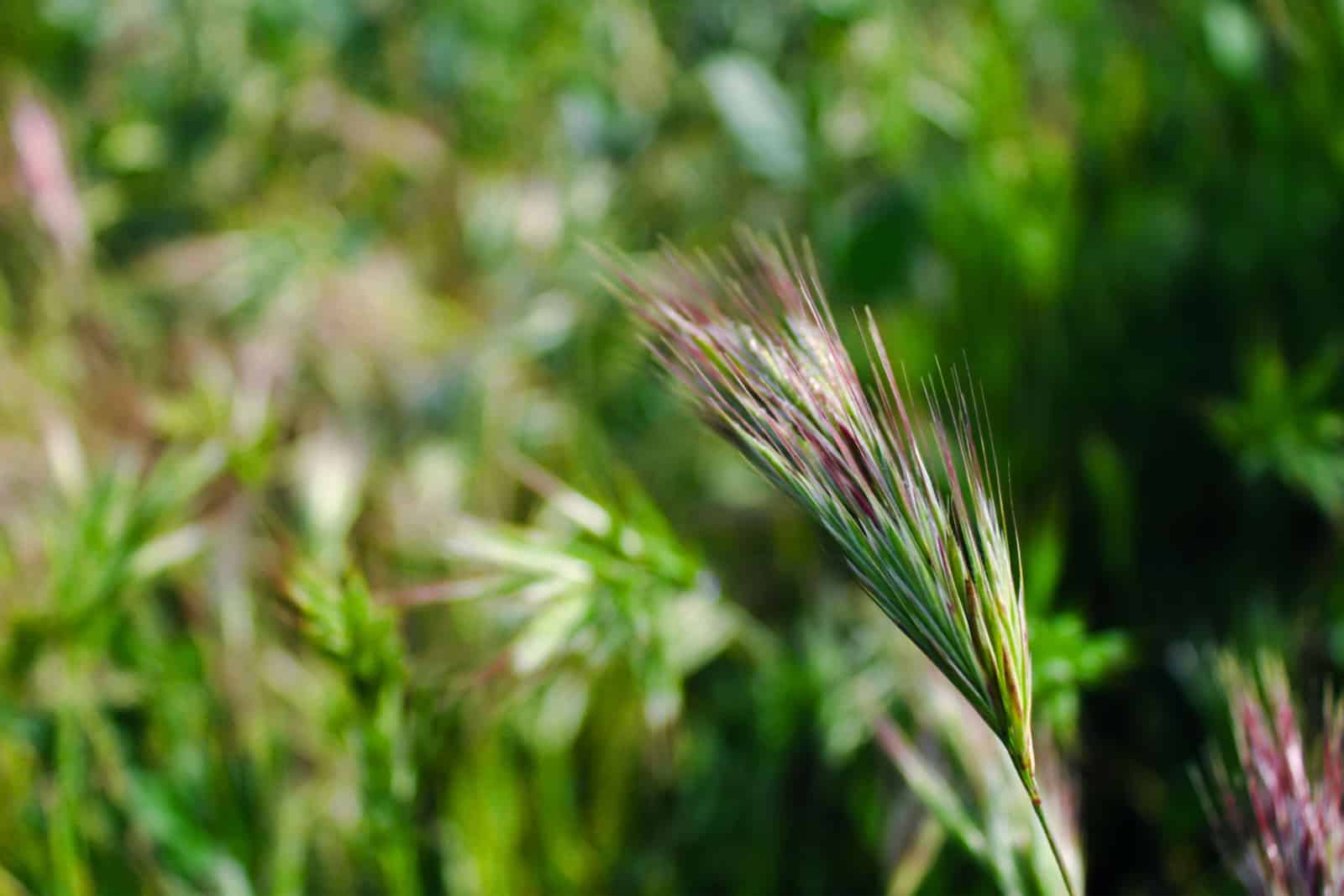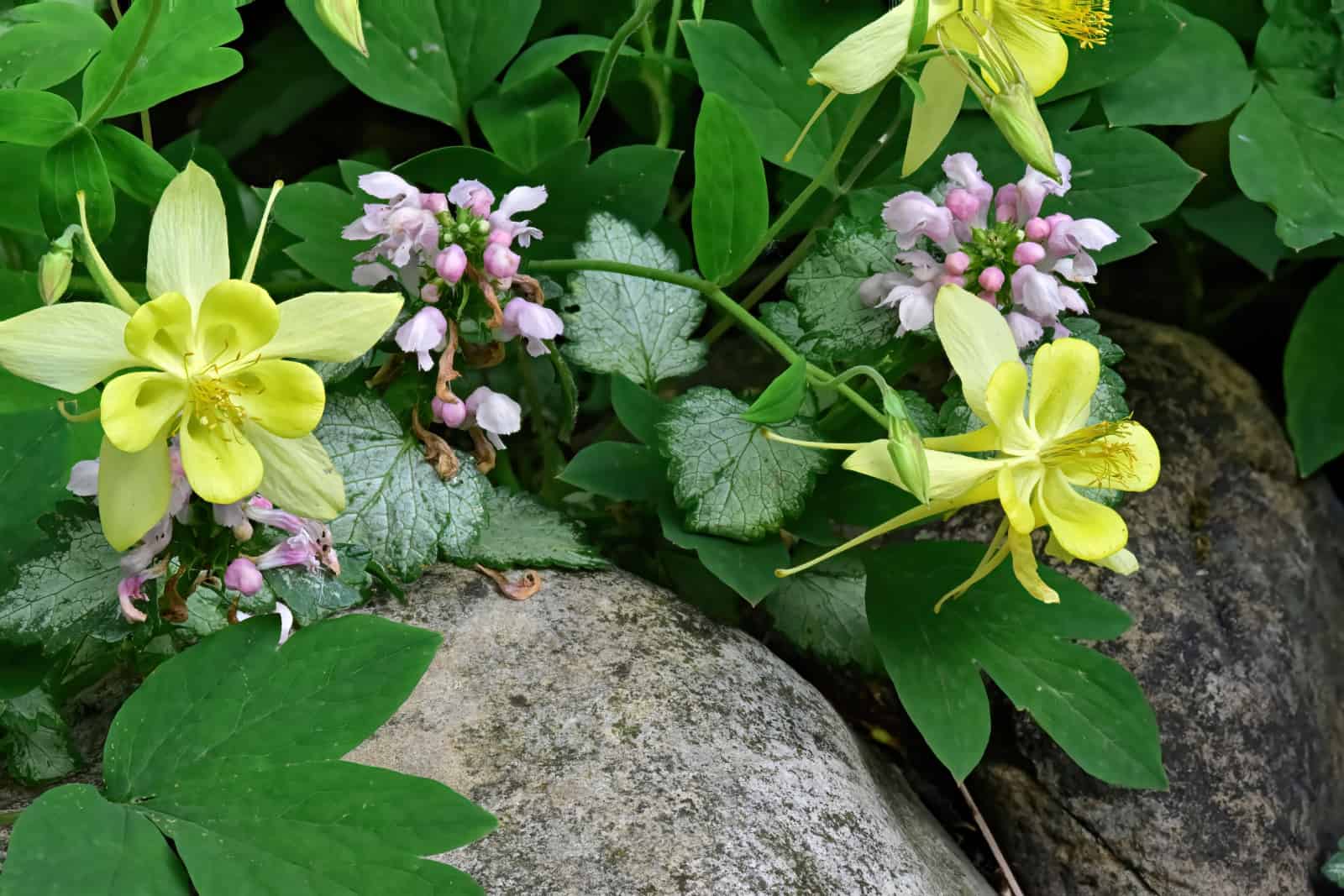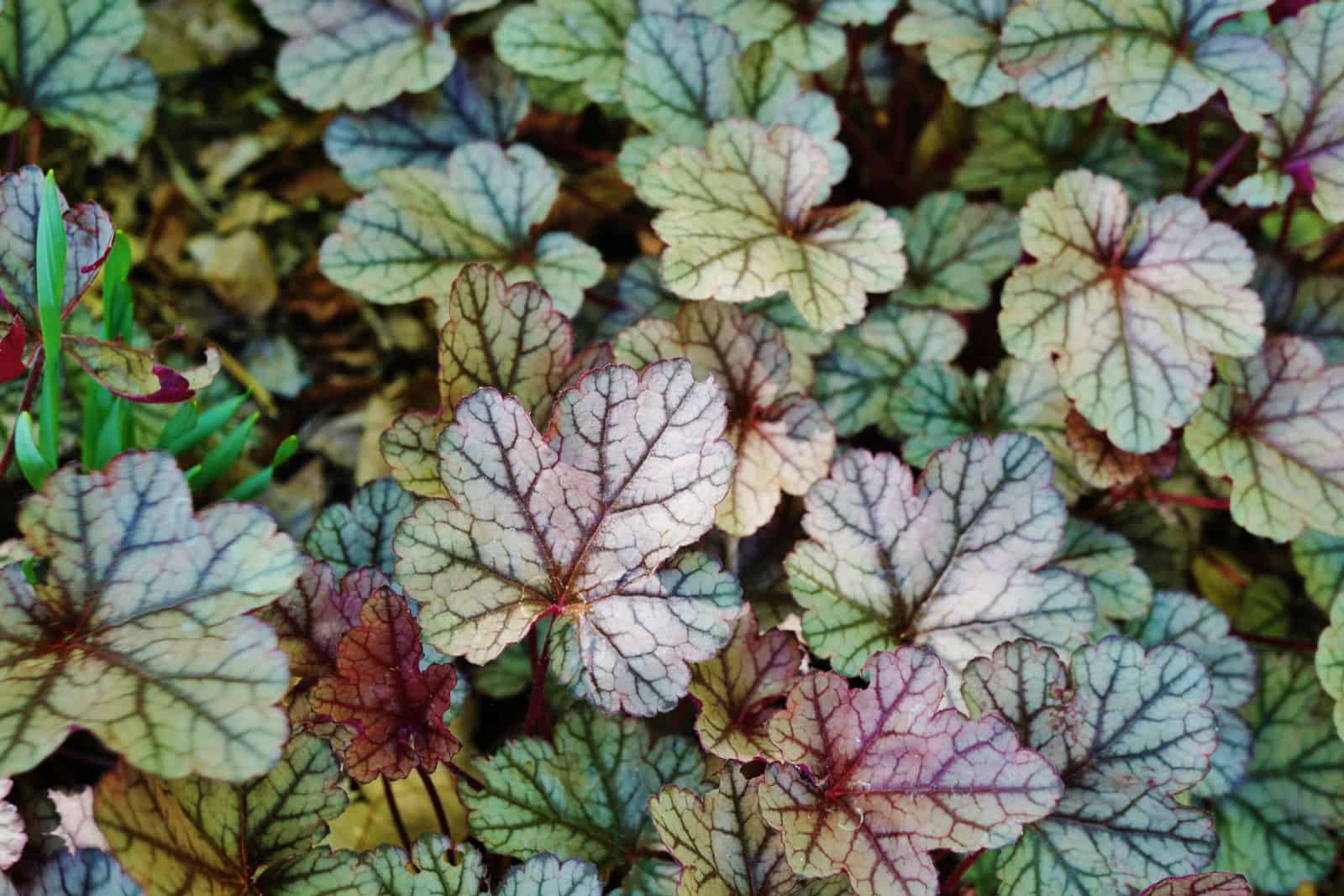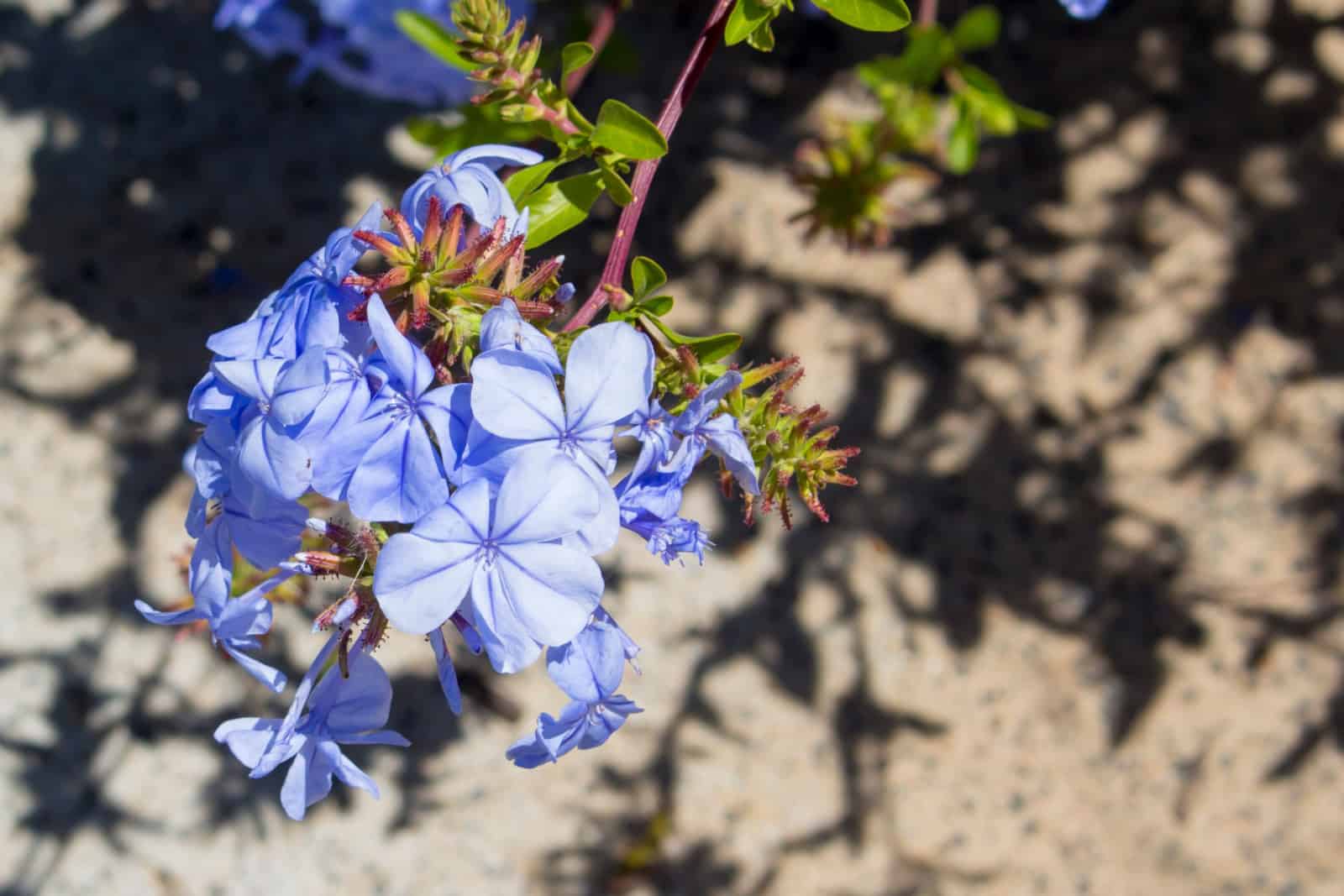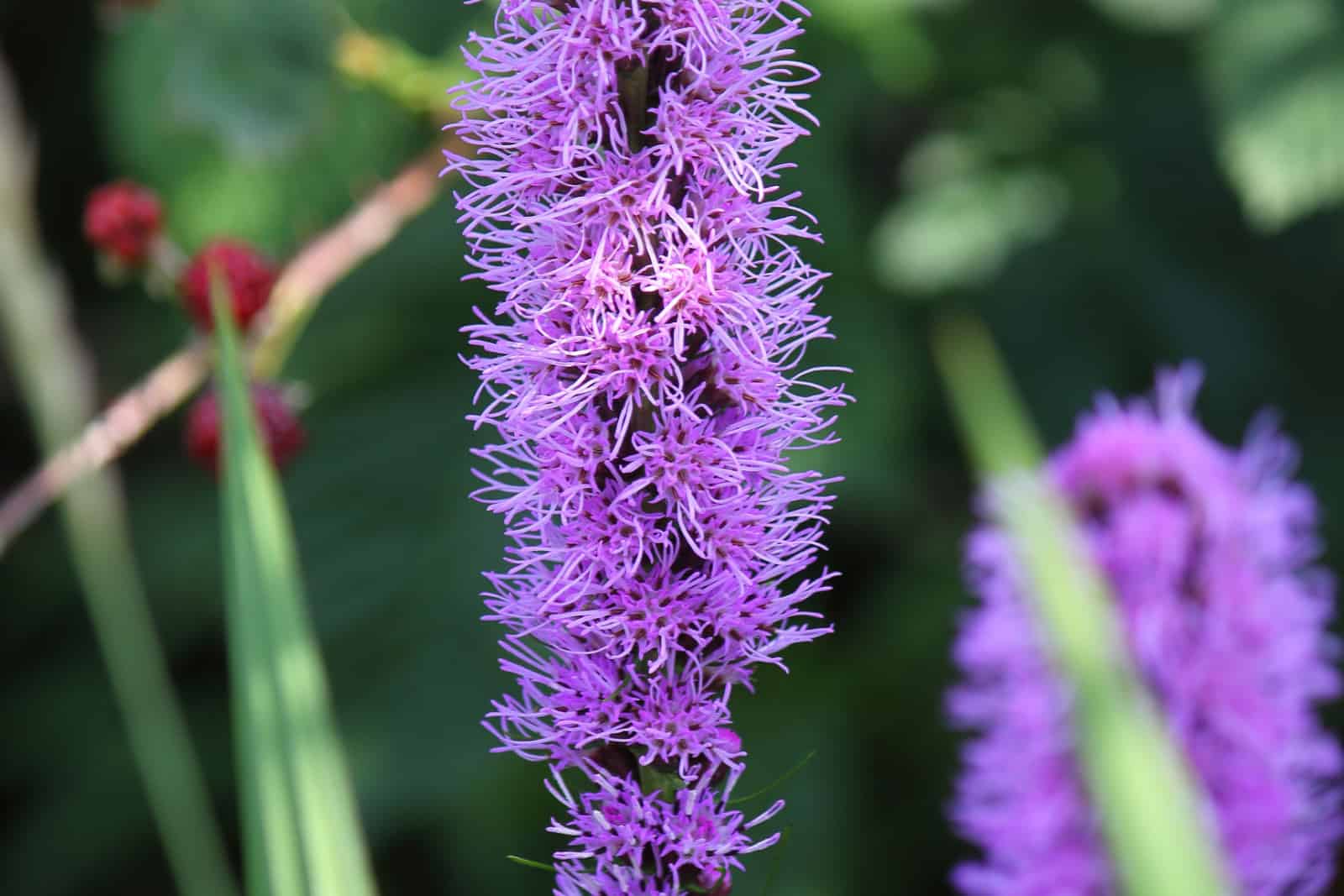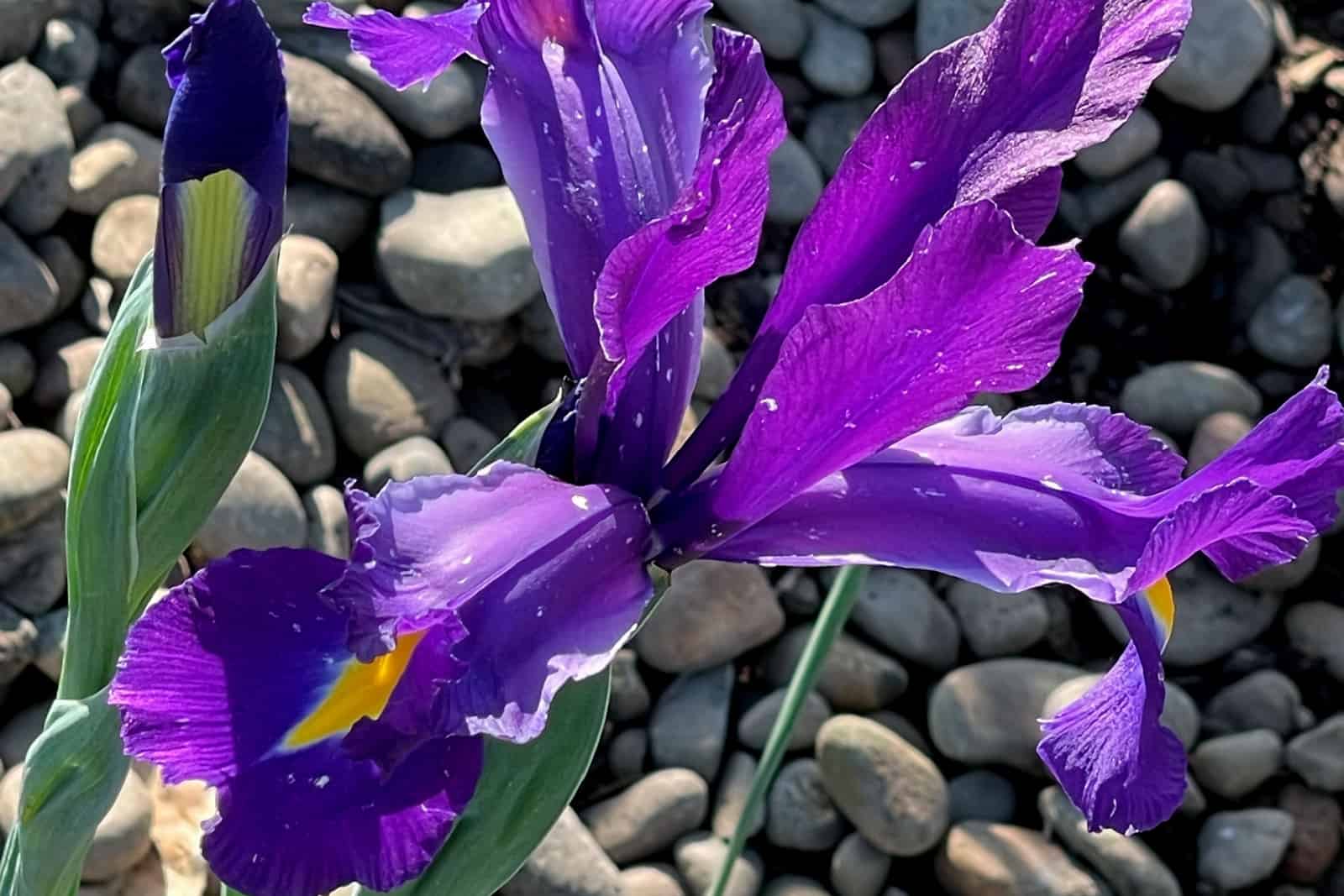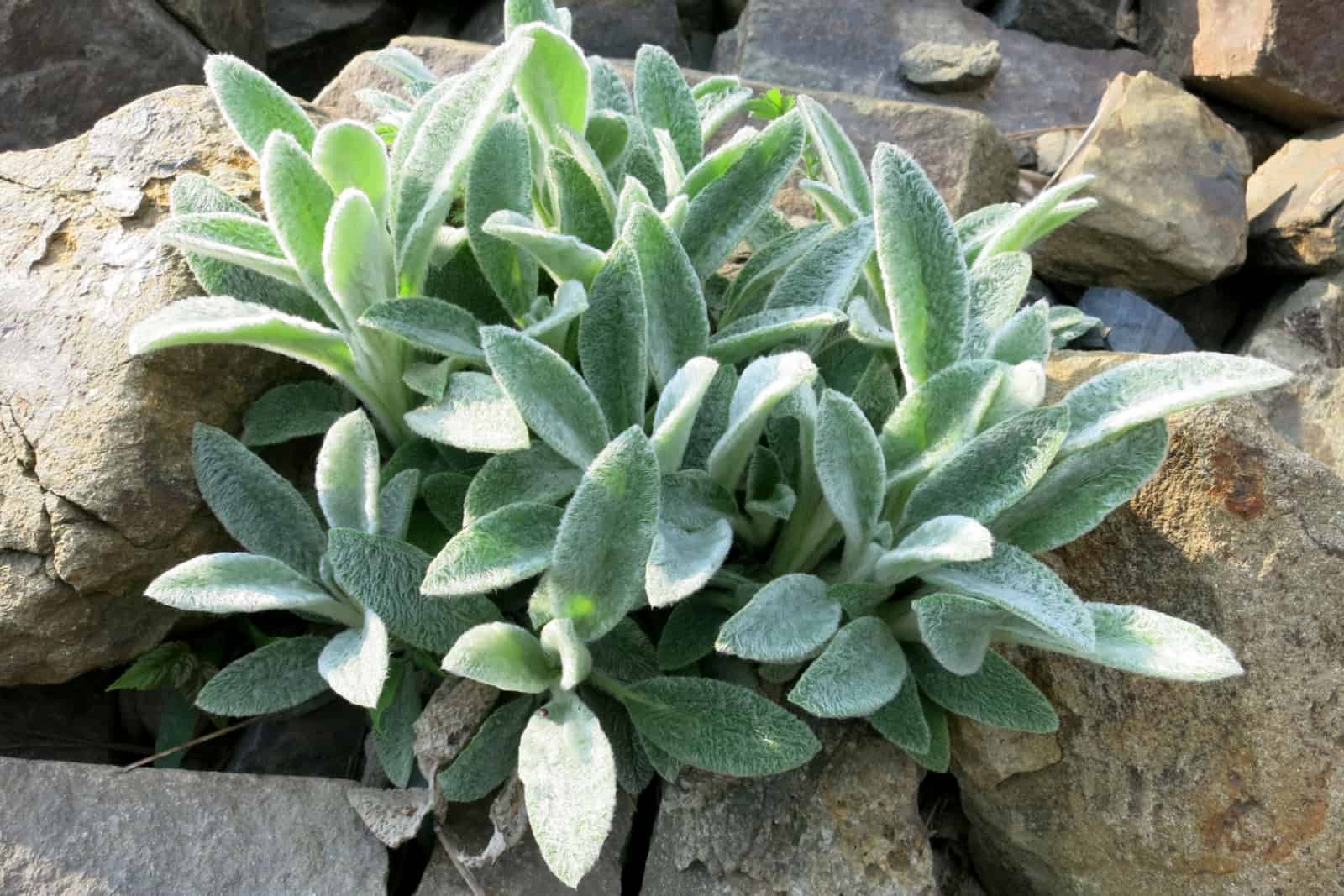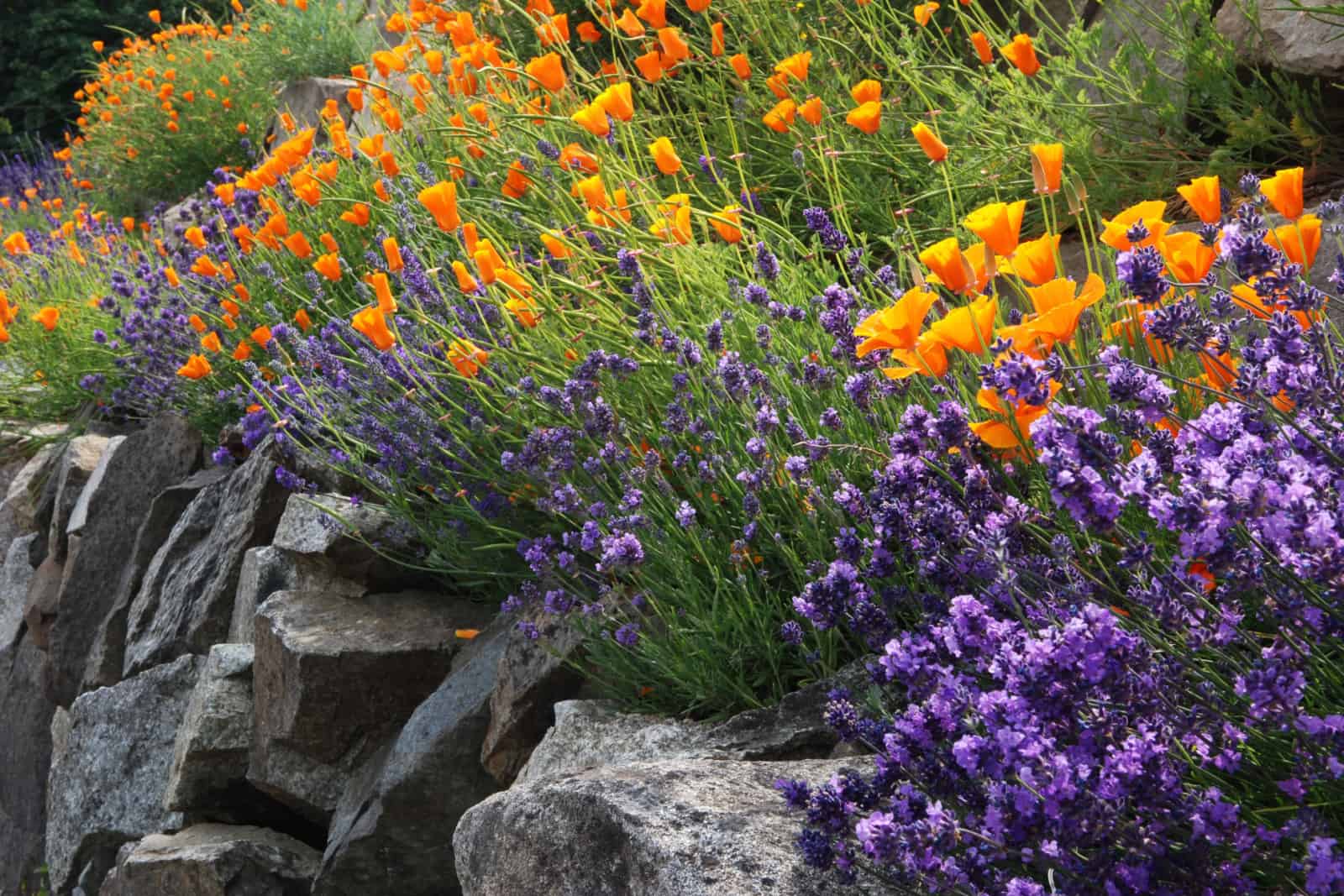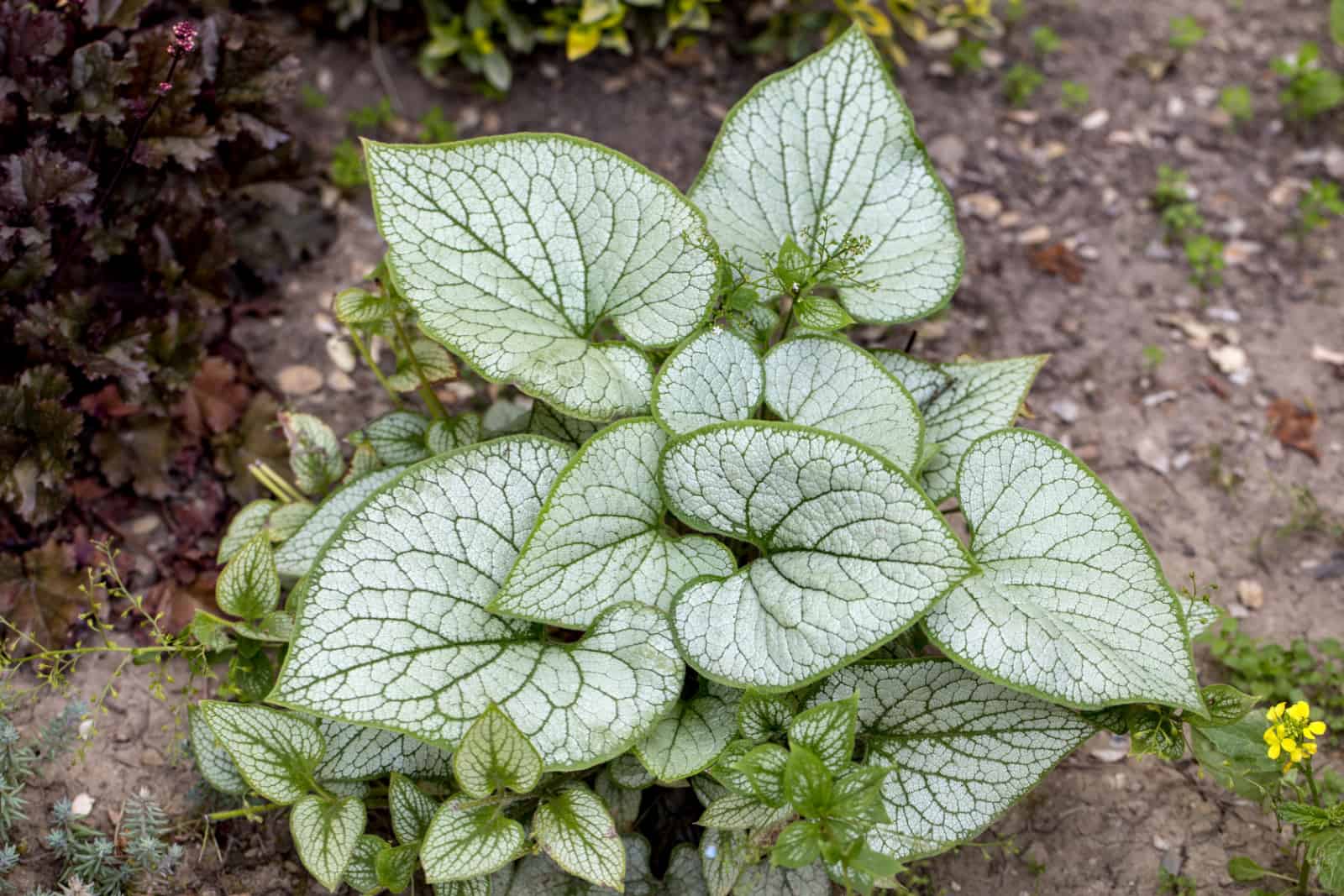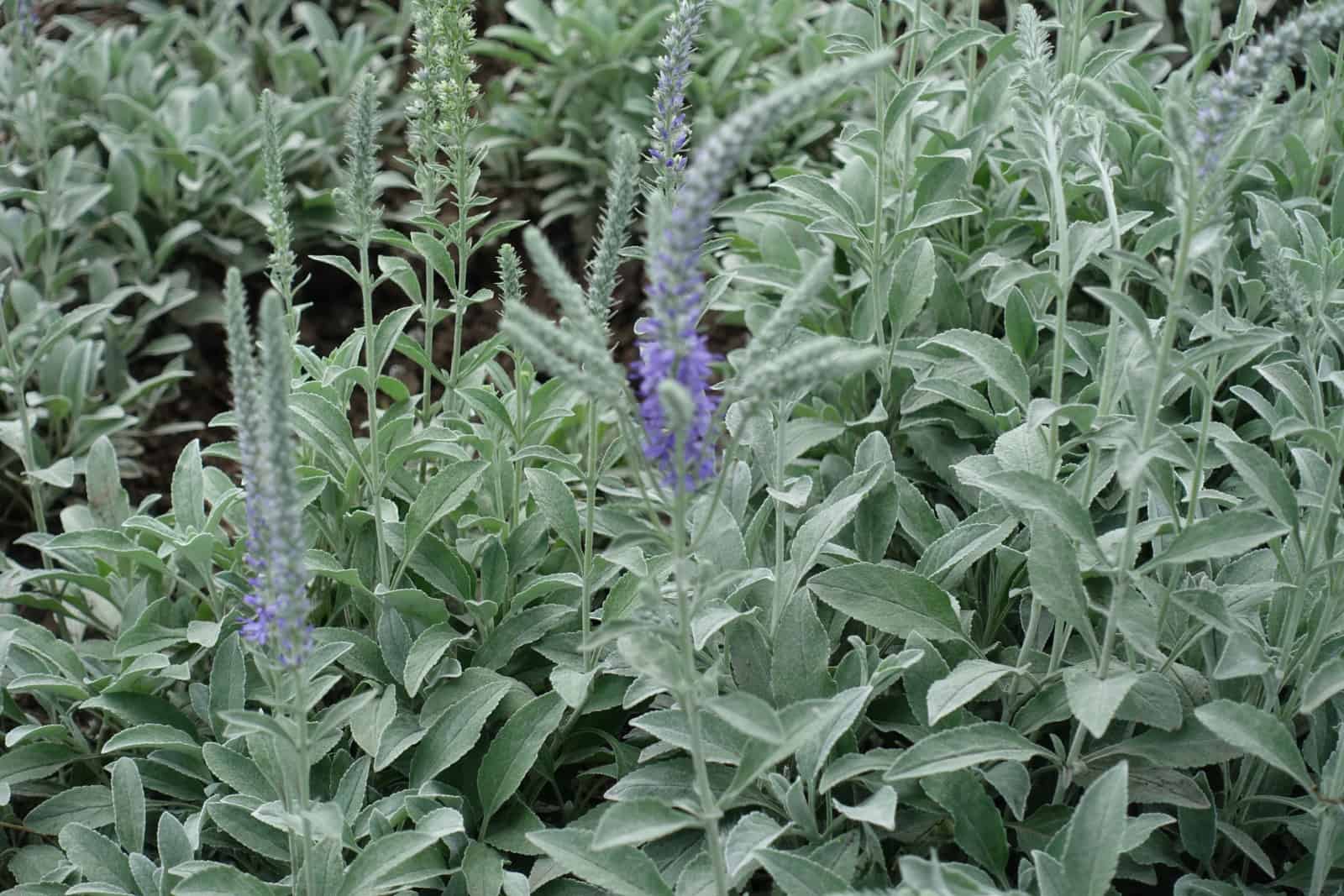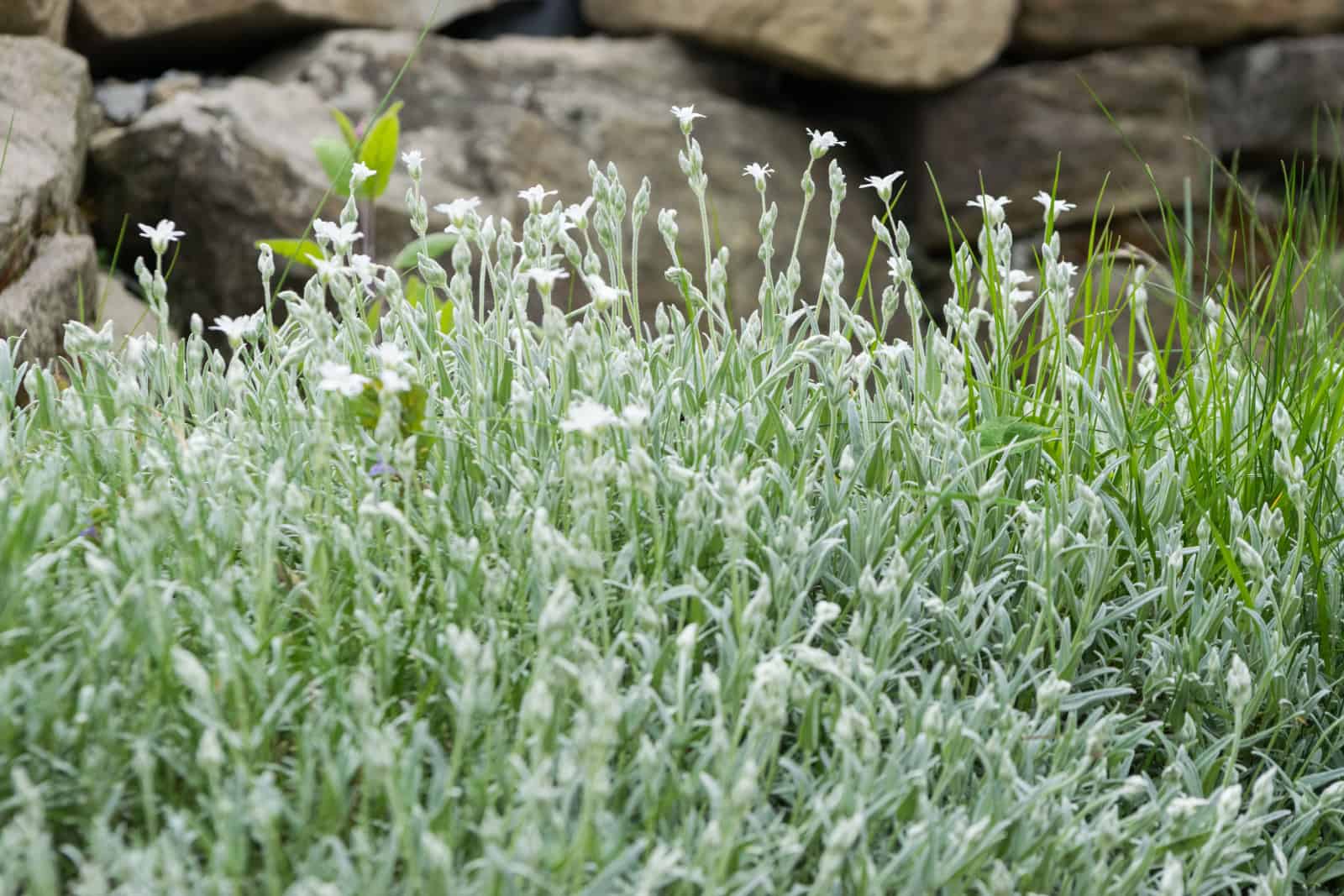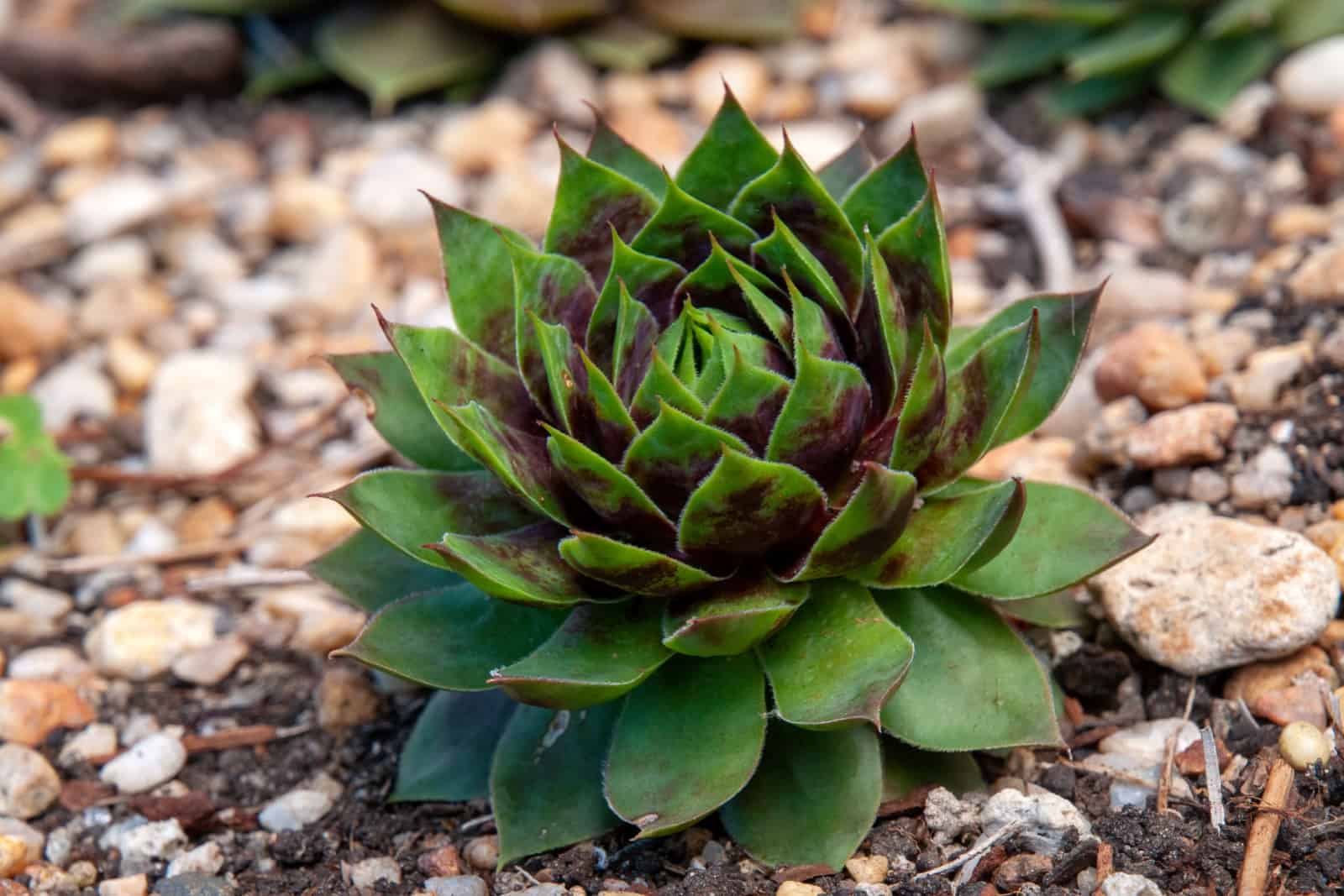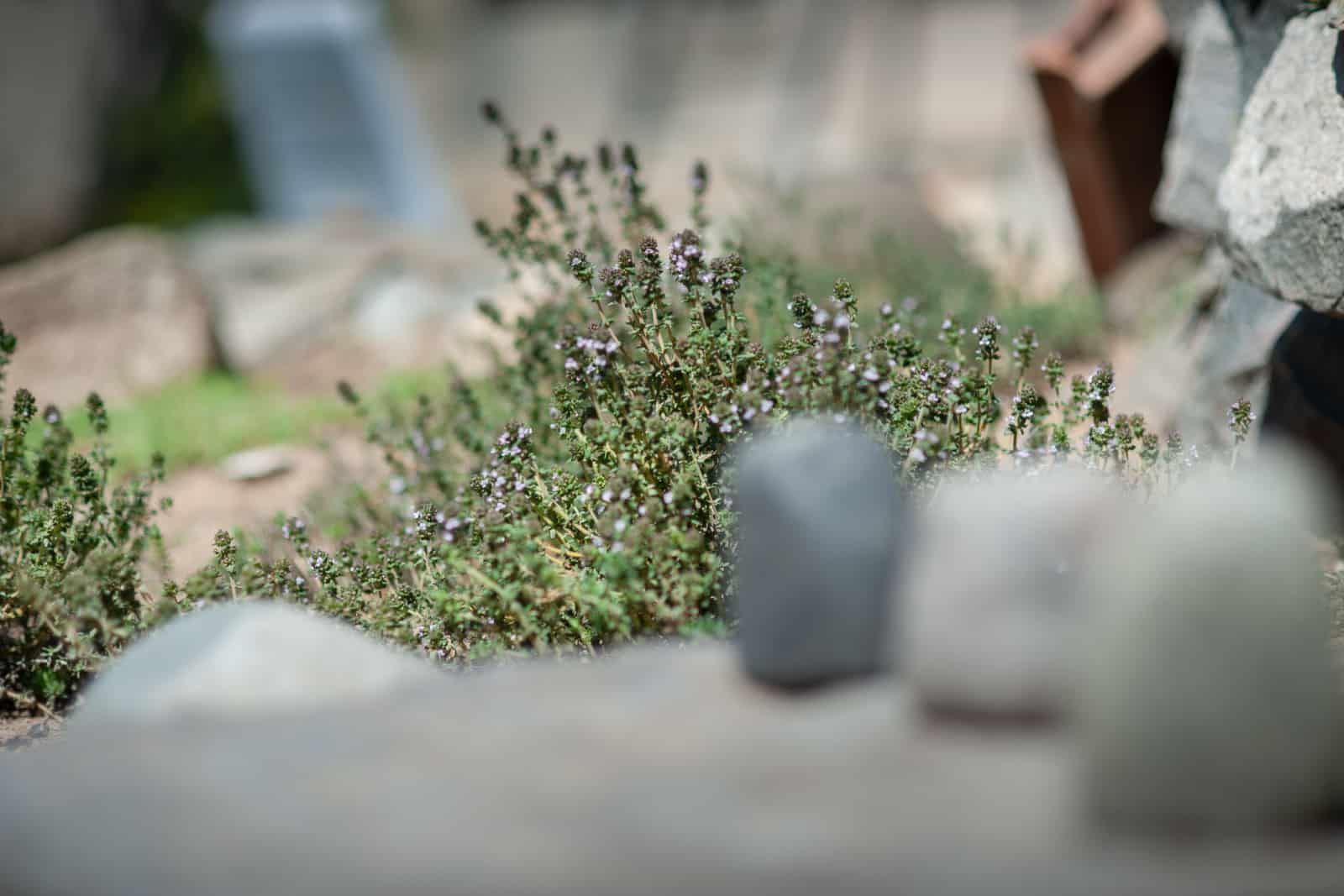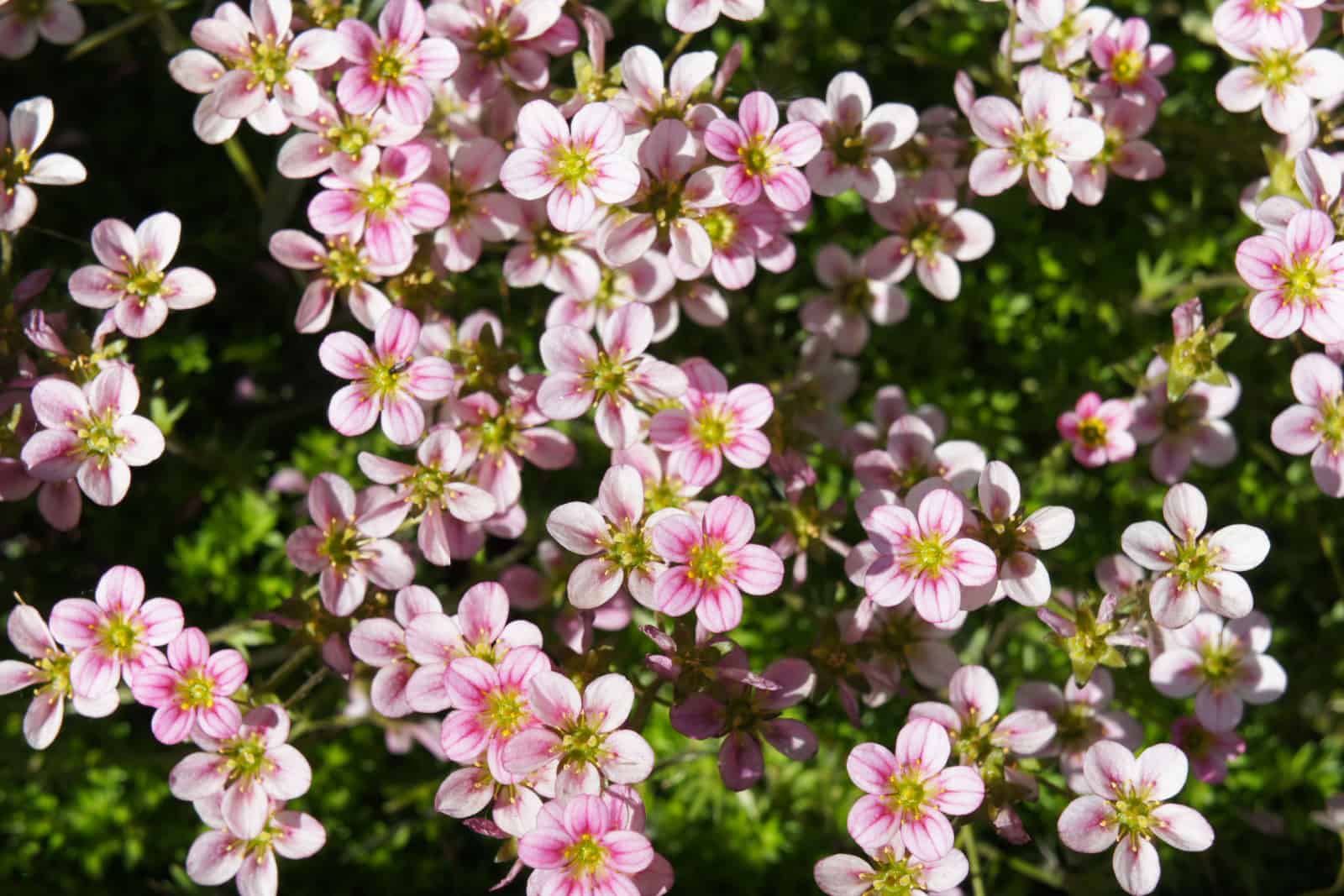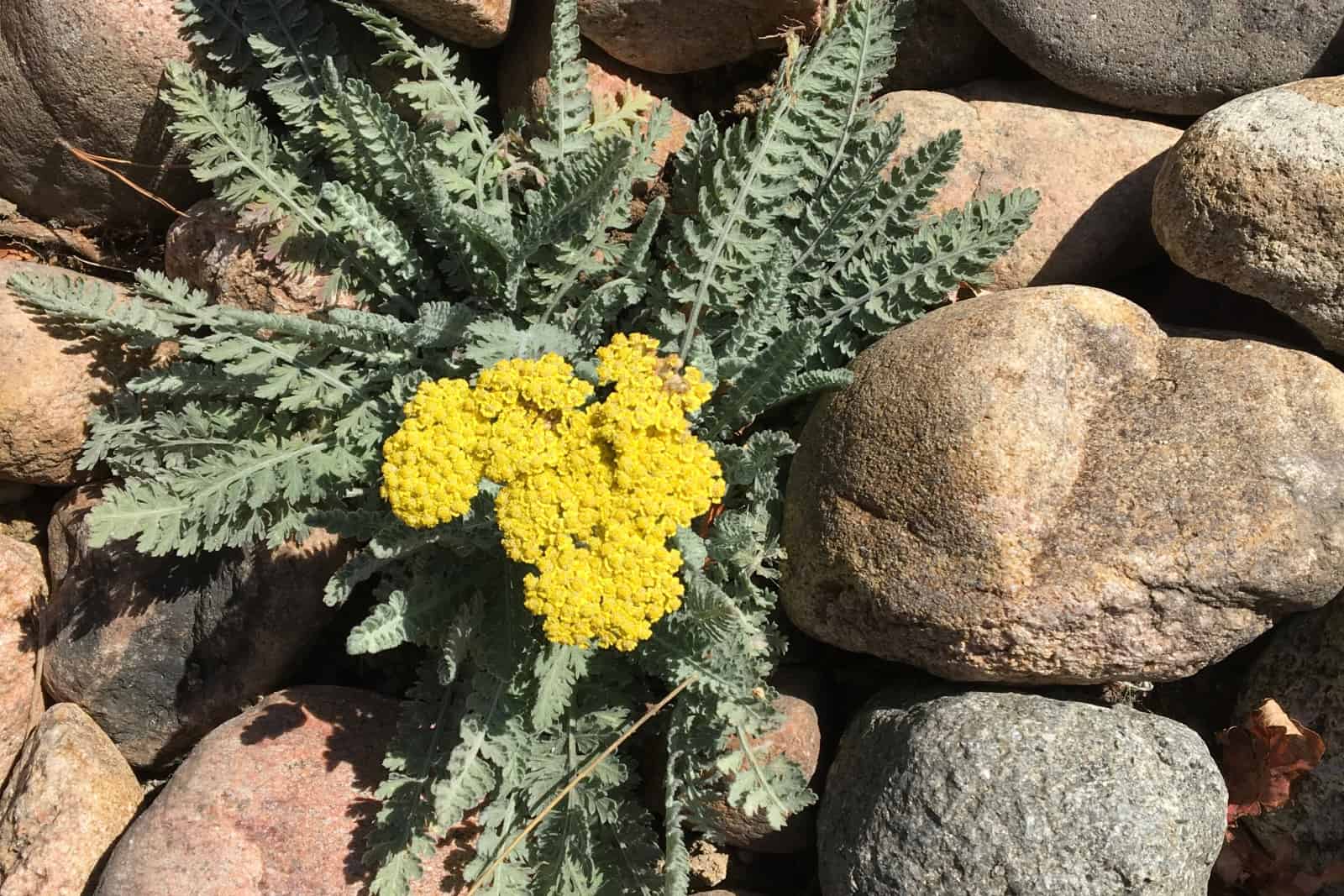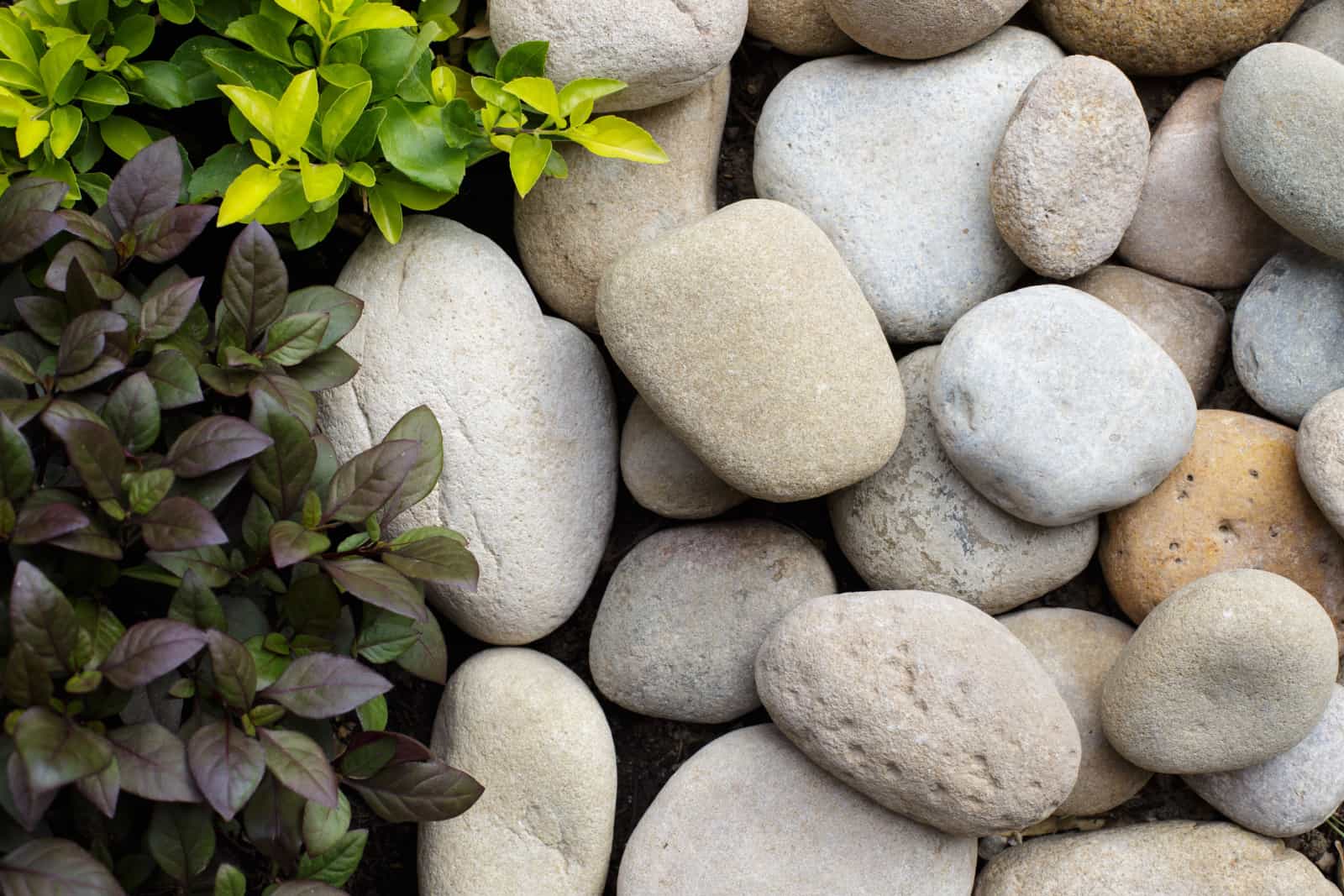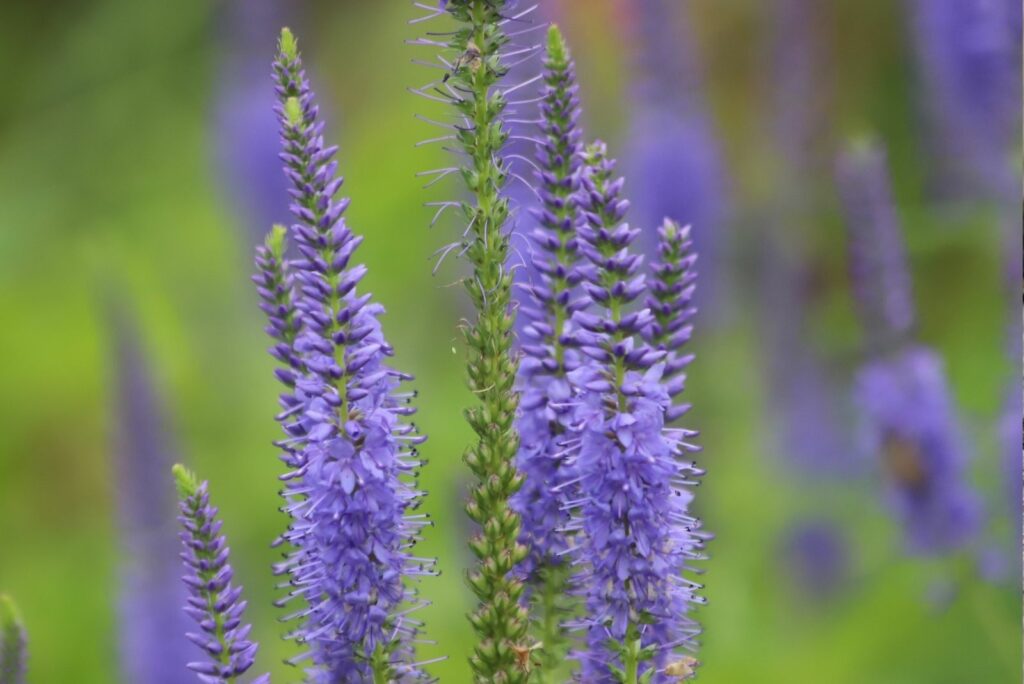Decorating a rock garden isn’t as easy as it seems, especially if you want to add some color to it.
Why complicate things? Just add some flowers!
Yes, there are rock garden plants that can thrive in unfavorable conditions, and below you will find 27 that you can incorporate into this stunning and affordable desert landscape idea.
Let’s take a closer look at all of them.
1. Alpine Alyssum
If you need to add color to your rock garden but don’t know where to start, the yellow-flowered alpine alyssum may be just what you need.
Of course, it cannot spring out of the rock, but if you add some regular garden soil mixed with pebbles and leaf mold, it’ll have everything it needs.
This plant generally doesn’t require moist and nutrient-rich mediums, but you can add a bit of compost to help it grow.
Give it plenty of light and water it scarcely for the best results. It is drought and heat-tolerant, so it’ll be more than happy in these conditions.
2. Aubrieta (Rock Cress)
The white or purple flowers of the aubrieta are a perfect addition to your rocky landscape.
Rock cress is a perennial ground cover that can get into crevices between stones, so it’s perfect for such a design.
One of the things I love most about this plant is that it can handle various conditions. However, it grows best when you neglect it a bit and keep it in rocky, sandy soils with full sun exposure.
Therefore, you’ll only need to water it during extreme heat and prune it after flowering to keep its shape and encourage more flowers.
3. Basket Of Gold
This golden-flowered plant can really elevate your rock flower beds!
It does best in regions with mild summers because it needs full sun exposure, and too much heat would only stress it out.
Unfortunately, I cannot grow it in Florida because it doesn’t tolerate humid environments, but if you live in a drier region, then it’s perfect for you.
It doesn’t tolerate moist and nutrient-rich soils, so make sure to amend your rock garden with well-draining materials such as a bit of topsoil, pebbles, and perhaps some peat moss.
4. Bellflower
Bellflowers in full blossom creeping between rocks and almost covering them entirely is one of my favorite things to see. It makes me sad that I don’t live in an arid region!
This species is hardy, and to see it thriving, you should expose it to at least 6-8 hours of sunlight each day. It can tolerate some shade, but it wouldn’t bloom as much.
And just like any rock garden plant, this one also requires excellent drainage. But unlike other species I’ve mentioned, this one needs more moisture, so you will have to water it once or twice a week.
5. Blue Fescue
This blue-colored ornamental grass will make your desert landscape pop.
And once you hear how low-maintenance it is, you’ll have a hard time resisting getting some!
It has a shallow root system, so it can easily adapt to poor and dry conditions. (1)
Therefore, you don’t have to alter the rocky substrate that much in order for your plant to thrive. Simply water it once you notice it’s droopy, and you’re good.
Blue fescue goes dormant in excessive heat, but it won’t die. You just need to prune the unsightly growth and wait for cooler fall weather for it to wake up.
6. Cactus
Cactuses are desert plants that come in all shapes and sizes, so it’s up to you to decide which one to get for your rock garden.
For instance, the Easter lily cactus is perfect for a dry and poor setting because it doesn’t have high demands.
You don’t have to fertilize these species since they have more than enough nutrients in the ground.
And when it comes to watering, you’ll be glad to hear that native cactuses need irrigation once a month if the temperatures exceed 90°F. If you have a non-native variety, water it twice a month.
At other times, native cactuses don’t need irrigation at all, while non-native ones require watering once a month!
7. Calliopsis
Also known as coreopsis, this plant will adorn your rock garden with golden or purple flowers.
It thrives in barely livable conditions, so you don’t have to do anything about the soil. Leave it with poor nutrient content and keep it in well-draining soil to prevent waterlogging.
This plant can tolerate drought and heat when established, but it flowers more abundantly if you water it regularly and expose it to plenty of sunlight.
And to make caring for it even easier, you don’t have to use any fertilizer if you grow this plant in the ground. But if you have soil that’s really low in nutrients, you can work in some compost when you plant it to get more prolific blooming.
8. Candytuft
The white, flowery balls crowning bushy greens of the Candytuft is all it takes to give your rock garden that special something.
But it isn’t just about the looks! This plant is highly resistant to heat and drought, and it thrives in well-draining substrates – all the requirements of a perfect rock garden plant.
You won’t find a better and easier-to-care-for rock garden plant than this. You don’t have to fertilize it, while established plants can go 2-3 weeks without water.
9. Chinese Juniper
This shrub has many different cultivars, whether you want to use it as a ground cover or add a coniferous centerpiece to your rock garden.
Like all junipers, this one can also tolerate a wide variety of soils, including dry, clay, sandy, and rocky substrates – as long as they have good drainage. (2)
These plants are hardy and naturally drought-tolerant, so they’re perfect for desert landscapes. Therefore, you don’t have to water established plants unless there’s a long dry spell going on.
Finally, if you want to entice them to grow, you should fertilize them a couple of times per year with a well balanced, slow-release fertilizer when planting, and then 16-4-8.
10. Chinese Silver Grass
This ornamental grass that resembles pampas is perfect for rocky gardens because it will add a soft texture and gentle colors to it.
It is suitable for almost all types of soils as long as they have good drainage. It is drought and salt-tolerant, so you can even grow it in coastal areas, unlike most other plants.
It doesn’t require plenty of nutrients, which is why adding it to a stone garden seems so natural. Expose your Chinese silver grass to at least 6-8 hours of direct sunlight and it’ll thrive.
However, bear in mind that it is a non-native plant, so it can become invasive in certain areas.
11. Columbine
Columbines are on the list of flowers that represent strength, and combining them with stone pieces can only accentuate their meaning.
This genus is native to mountainous and rocky terrain, so it tolerates less-than-adequate conditions well. You can grow it in reasonably moist or dry soils, rocky, sandy or clay substrates, expose it to full sun or part shade, etc.
You don’t even have to water it once it gets established; only after its foliage starts to droop.
The columbine flower doesn’t require fertilizer, but some nitrogen-rich plant food can entice it to develop faster. You also don’t have to prune it; just deadhead the spent flowers and you’re good to go! (3)
12. Coral Bells
The array of colors this plant has to offer is immense, so there’s bound to be a shade that’s perfect for your landscape.
Furthermore, this species has shallow roots and a moderate growth rate, making them perfect for rock gardens.
But unlike some other plants we mentioned, they require a fair amount of nutrients in order to thrive, so make sure to amend your soil with compost.
They also thrive in partial shade, so 4-6 hours of direct light each day is more than enough.
Another thing that differentiates the coral bells from other plants we mentioned is the fact that you need to water them regularly. Established plants can go a week or so without rainfall or irrigation, but newly planted ones require a daily supply of moisture.
13. Ferns
Adding ferns to your rock garden might seem strange at first because we all know they love moisture.
However, species such as the Davallia fern can thrive on rocks without any soil as long as you water them every couple of days and keep the stone moist.
Other varieties, such as the lip and northern maidenhair ferns, require loose and gritty soils that retain a bit more moisture.
However, all these species are drought-tolerant and sun-loving, which makes them suitable additions in rocky landscapes. In fact, some even grow on rocks in their natural habitat, so putting them in your stone garden isn’t that strange.
Here’s a fern species that can grow solely on rocks:
14. Hardy Plumbago
If you have a rock garden in a shady location, then the hardy plumbago is the plant for you.
It will exhibit plenty of blue flowers even when there isn’t that much light, although it prefers sunny locations
The hardy plumbago has low watering needs and thrives in dry or slightly moist soils, which makes it suitable for rock gardens.
It doesn’t mind substrates low in nutrients, so you don’t have to fertilize it. However, a handful of compost before planting would definitely help it grow.
15. Hummingbird Mint
If you’re making a themed rock garden and need some plants that look like lavender, then hummingbird mint is ideal.
This perennial herb can handle various types of soil, whether they’re on the dry side or a bit more moist. Its only requirement is to be well-draining.
Also, it needs 6+ hours of direct sun each day to reach its full potential, and water whenever you notice its leaves are drooping. Of course, young and newly-planted plants need regular irrigation, so bear that in mind.
16. Iris
Rock garden irises take you by surprise once they show their short height and reveal their yellow and blue heads.
This plant does require a bit of extra care, but you’ll get the hang of it in no time, I’m sure. It needs well-draining and fertile soil to support its growth, so don’t forget to amend your rock garden if it doesn’t have such conditions.
Water it regularly in spring once the topsoil dries out a bit, and cease irrigation in summer when they go dormant.
Rock garden irises grow best in full sun, but if you live in a particularly hot climate, I’d recommend ensuring some shade in the early afternoon.
17. Lamb’s Ear
The velvety, hairy, and silvery-green leaves of this plant resemble lamb’s ears, hence the name.
But what makes it suitable for rock gardens, aside from its looks, is the fact that it can thrive in drought and substrates low in nutrients.
You can give it an inch of water per week, but nothing bad would happen if you forgot about it. The plant will just shed its older leaves – but don’t keep it in the dry for long.
Additionally, you won’t have to fertilize it at all. Simply work some compost into the soil when you plant it, and it should be more than enough to sustain it.
18. Lavender
This Mediterranean native is perfect for rocky and poor substrates since those are the same conditions it comes from.
Plant your Spanish lavender (or English, French, lavandin, etc.) in infertile soil with great drainage, and you’ll see how it thrives.
You also don’t have to water it that often – only during dry spells after it’s established.
Fertilizer is also a no-go, but you can use a handful of compost when you plant it.
Finally, the only requirement this plant has is pruning once a year so that it doesn’t become woody and stop blooming.
19. Pasque
Ferny foliage and silky flowers make the pasque a favorite rock garden addition.
Most species from this genus are native to mountain regions, which makes them more than suitable for stoney landscapes.
Plant the pasque in a full sun location with a well-draining medium. Add some compost and gritty materials to make the soil perfect for your green buddy.
And once it establishes, the pasque will self-sow and multiply all over your rock garden, cutting your chores in half.
Finally, this plant is drought-tolerant, but it still requires regular irrigation during hot summers.
20. Siberian Bugloss
The blue blossoms and green foliage make this plant an interesting addition to your rocky landscape.
It has a low growth habit, making it a suitable ground cover for these settings. It’ll cascade in a slopey manner down the rocky terrain with ease, and you won’t even have to care for it too much.
Siberian bugloss thrives in moist, well-draining soils and is drought-tolerant once it establishes. Therefore, you only need to irrigate it during dry spells, and if you mulch it, you won’t even have to do that.
However, unlike many of the other plants I mentioned, this one requires plenty of organic matter to reach its full potential. It will grow in poorer soils, just not as well.
Plant it in partial shade (direct sun in the morning and shade in the afternoon) and it’ll thrive.
21. Silver Speedwell
The gray foliage and purple flower stalks of the silver speedwell will add a splash of color to any design.
And once you hear about its drought-tolerance and ability to cling to stones, you’ll definitely want to use it in your rock garden.
The silver speedwell requires consistent soil moisture, so you should water it more frequently than your other rock garden plants. However, it needs a fast-draining medium, as this can easily lead to waterlogging.
Expose it to full sun and prune the spent flower spikes to encourage more blooming.
22. Snow-In-Summer
The silvery-white blossoms that appear on the dark green foliage may be exactly what your stone garden requires.
The snow-in-summer is a hardy plant that thrives in USDA hardiness zones 3-7 and needs full sun to thrive. But if you live in a warmer climate, then partial shade is the way to go!
What makes this plant perfect for rock gardens is the fact that it flourishes in nutrient-poor substrates with great drainage.
Therefore, it’s perfect for sandy soils, but you will have to water it more frequently in this setting.
Finally, cut it back once the flowering season is over.
23. Spring Gentian
The spring gentian lights up any location with its ultramarine blue flowers. But what makes it suitable for stoney landscapes?
Because it is an alpine plant, it can adapt to various stressful conditions, such as drought, cold, and a lack of sunlight and nutrients. (4)
Therefore, the spring gentian is perfect for rock gardens where growing conditions are far from ideal.
But if you want to aid its development, you can amend the growing medium with compost to add more nutrients. However, ensure that the drainage is excellent so as to avoid root rot, and plant it in a location with at least 6-8 hours of light (partial shade is fine in warmer regions).
24. Succulents
When we think of succulents, it’s usually aloe, agave, or a hen and chicks plant that springs to mind, and we imagine them in desert settings. We’re not wrong, either!
These plants are native to arid climates and infertile soil, which makes them perfect for your rock garden and xeriscape landscape.
Plant your campfire succulent (or any other variety) in sandy, fast-draining soils to avoid waterlogging and root rot. You can also apply some compost or humus to add nutrients to the medium, but don’t use too much since it can end up retaining excess moisture.
Keep them in a full sun location and water them 1-2 times a month. These species have fleshy leaves that retain plenty of moisture, so irrigating them any more frequently than this will lead to rotting.
25. Thyme
There are many thyme varieties out there, and the one you choose depends on your landscape vision. For instance, creeping thyme is perfect for rocky designs because it will fill all the empty spaces and create a soft mat between harsh stones.
Since it’s native to the Mediterranean, this plant can easily adapt to the dry and infertile conditions of stone gardens.
It is drought-resistant, so you only need to water it during prolonged dry periods.
Plant it in soil with excellent drainage and ensure that there aren’t too many nutrients in it. You can add some compost, but too much will increase water-retention and put your plant at risk of root rot.
Finally, place it where it can get at least 6-8 hours of direct light each day, and it’ll reward you with an abundance of tiny purple blossoms.
26. Touran Pink
The white blooms with pink borders of the touran pink resemble cherry blossoms, and who wouldn’t want a dash of spring in their rock garden?
This alpine plant is perfect for stone landscapes because it is drought-tolerant, doesn’t require many nutrients, thrives in gritty soils, and loves rock mulch.
Water it only during dry spells, don’t use too much compost when planting it, and make sure that its growing medium drains well.
Finally, you should expose it to direct sunlight in the morning and shade in the afternoon since this mimics its native habitat down to a T.
27. Yarrow
This genus has many different species that come in various colors, from soft pastels to vibrant orange, red, yellow, and purple.
There are also many great companion plants for yarrow, so you can add them to various places such as vegetable gardens, flower beds, and rocky landscapes.
Because this plant tolerates dry and less fertile soils, it can flourish in stone gardens.
However, it can also grow in regular mediums, so you don’t have to panic if you add compost.
Expose it to full sun for the best blossoms, and give it half an inch of water each week to support its growth.
Here’s How To Grow Plants On Rocks
Choose your rock – Use rocks with high porosity so that they can retain moisture for longer periods. These include lava rocks, slate, and sandstone. Limestone and granite are also great options since they can endure various weather conditions.
Use specific soil mixes – The medium for rock gardens needs to have excellent drainage, which is why you should use specific blends. There’s nothing wrong with garden soil, but it can retain too much moisture. Amend it with gravel, peat moss, leaf mold, and add a handful of compost to avoid this.
Add fertilizers – If you’ve already added compost to your soil mix, there’s usually no need for additional fertilizers. However, certain plants benefit from regular fertilization, so you can add some organic fertilizer throughout the growing season. Compost and manure are the best options since you won’t overfertilize your plants with them.
Mist and water regularly – Plants in rock gardens generally don’t require that much moisture as they’re all drought-resistant. You can water these plants once you notice they’re drooping, or install a drip-irrigation system to reduce your chores.
And if you’re really intent on growing plants on rocks without any other medium (such as some ferns that can grow this way), then you should irrigate them every couple of days. The stone surface quickly dries out, which can be detrimental to your green buddy.
Finally, the watering frequency for indoor plants generally depends on air circulation, temperature, and light exposure. Take these things into account and watch out for signs of underwatering such as dry topsoil and droopiness before watering your plants.
Common Issues With Plants On Rocks
1. Pests – There are many pest-resistant alpine plants you can add to your rocky landscape to prevent infestations, but not all of them are resistant. Luckily, you can get rid of them by spraying some organic insecticides.
2. Diseases – The most common infections that occur in rock garden beds are root rot and powdery mildew. The cause is too much water in both cases, although powdery mildew is less dangerous and usually occurs on the foliage. In the case of root rot, remove the diseased roots, and for powdery mildew, prune the infected foliage.
3. Drought – Not many plants can handle the drought conditions present in rock gardens, which is why you should choose species suitable for these conditions. And, of course, water your plants once you notice any underwatering symptoms.
4. Heat – Stones can get extremely hot during summertime and burn your plants. Therefore, planting heat-tolerant species that can tolerate partial shade and using white stones that reflect light, and don’t get as hot as black ones, can help you out.
5. Wind – Rock gardens often don’t have any protection, so planting some trees in them to keep your alpine plants safe or building an attractive shelter can reduce this issue. Heavy rains can also cause the same damage, but the solution is the same.
Final Thoughts
The 27 rock garden plants in this article are perfect for any setting, whether you want a more desert look or you’re down for some alpine greenery.
Most of these species are drought-resistant and don’t require fertile soils, but it all depends on the variety.
Finally, growing them might be a bit tricky, so I included some tips for nurturing these plants and dealing with their common issues.
Until next time!
References:
1. Zhao, Y. et. al. (2017). Do Shallow Soil, Low Water Availability, or Their Combination Increase the Competition between Grasses with Different Root Systems in Karst Soil?. Environmental Science and Pollution Research.
2. Westerfield R. R. (2022). Junipers. University of Georgia Extension.
3. Nicholls, G. (2002). Alpine Plants of North America: An Encyclopedia of Mountain Flowers from the Rockies to Alaska. Timber Press, Portland, OR.
4. Billings, W. D. & Mooney, H. A. (1968). The Ecology of Arctic and Alpine Plants. Biological Reviews.

